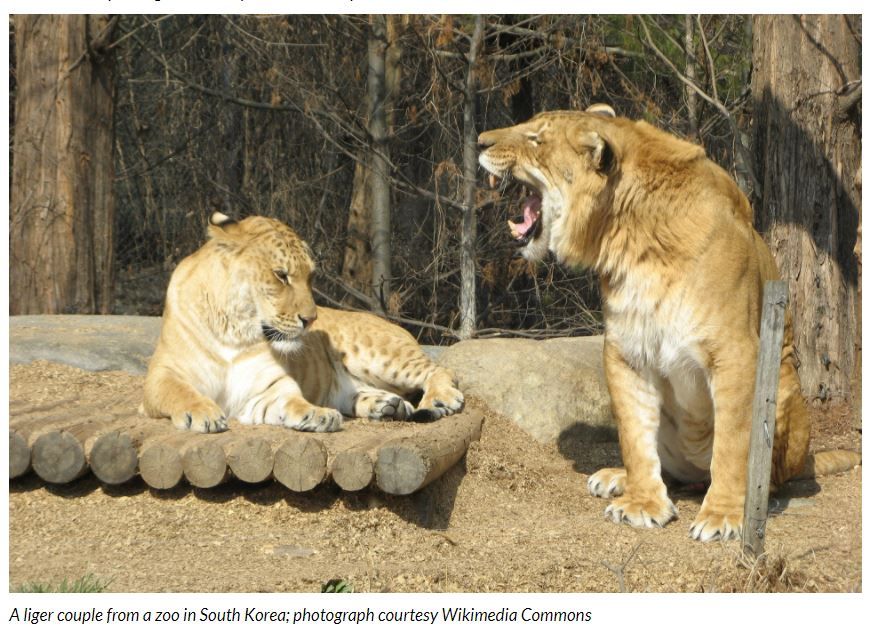
|
LIGERS |
A liger is the offspring of a lion and a tigress. It is bigger than either parent, 10 - 12 ft in length - making it the biggest hybrid cat and, for many people, the most fascinating. L Reisinger(1929) reported a male liger as weighing as much as both parents together.
Ligers are the largest big cat, tending towards gigantism, especially in the males which can be the size of a pony and weigh over half a tonne. Some researchers suggest this is a throwback effect to the huge size of the related extinct "cave lion" though the effect is actually due to "growth dysplasia" (see below). The male liger reportedly has a gentle disposition which may be due to lack of testosterone (male hybrids are usually infertile). Some male ligers have more mane development than others and some are almost mane-less; this is comparable to variable mane sizes in wild lions. Because of public fascination with giant cats, the liger is now more common than the tigon. Although ligers are claimed to be relatively docile, their size and strength still makes them very dangerous when excited or defensive. In october 2008, a handler at an animal sanctuary near Tulsa was fatally mauled by a 1000 lb liger called Rocky when he entered its enclosure while it was feeding (a violation of the zoo's rules). The handler was bitten on the neck and back and died in hospital the following day. When Rocky was younger, it was possible to ride him like a horse. Although the handler was at fault, the liger may be destroyed.
Ligers vary in appearance depending on how the genes interact and on which subspecies of lion and tiger are bred together. According to AP Gray in Mammalian Hybrids, the basic colour of lion/tiger hybrids is pale ochre to rust yellow-brown, more intensive than in the lion, but paler than in the tiger and with tiger striping. The mane of the males develops late and is shorter than that of a lion. In general, males grow sparse leonine manes and the facial ruff of a tiger. Males and females have spotted bellies and a striped back. They roar like lions and "chuff" like tigers. The females exhibit conflicting needs for lioness-like sisterhood and tigress-like solitude. Ligers have no scientific name, but Panthera leo X tigris has been posited. The highest population of ligers is in the USA (legal loopholes in some regions mean hybrids are permitted where private ownership pure lions or tigers are prohibited). Their impressive size makes them an attraction in roadside zoos, but when the zoos are closed down or the owners relinquish the oversized hybrids the lucky ones end up in sanctuaries.

In "The Variation Of Animals And Plants Under Domestication" Charles Darwin wrote: "Many species of Felidae have bred in various menageries, although imported from diverse climates and closely confined. Mr. Bartlett, the present superintendent of the Zoological Gardens (18/17. On the Breeding of the Larger Felidae 'Proc. Zoolog. Soc.' 1861 page 140.) remarks that the lion appears to breed more frequently and to bring forth more young at a birth than any other species of the family. He adds that the tiger has rarely bred; "but there are several well-authenticated instances of the female tiger breeding with the lion." Strange as the fact may appear, many animals under confinement unite with distinct species and produce hybrids quite as freely as, or even more freely than, with their own species." The voluntary hybridisation of some zoo animals is also referred to as hypersexuality.
In Nicholas Courtney's (editor) book "The Tiger, Symbol Of Freedom", it stated "Rare reports have been made of tigresses mating with lions in the wild." A.A. Milne writing in chapter 3 "Tiggers Can't Climb Trees" says that "Under exceptional circumstances it has been known for a tiger to be forced into ranges inhabited by the Asian lion, Panthera leo persica, which is the same genus as the tiger. Rare reports have been made of tigresses mating with lions in the wild and producing offspring known as ligers. When a tiger and a lioness mate the cub is called a tigron." Milne may be referring to the Gir Forest where both species are currently found or to the Persian (Asiatic) lion's historic range which was much larger than it is today and extended into North Africa. Milne also wrote that lions and tigers have cross bred in captivity for centuries (correct), and that the offspring are always sterile (correct with regard to male offspring only). Large brown cats (larger than lions or tigers) were reported anecdotally from Singapore and it has been theorised that they might have been wild-born ligers.
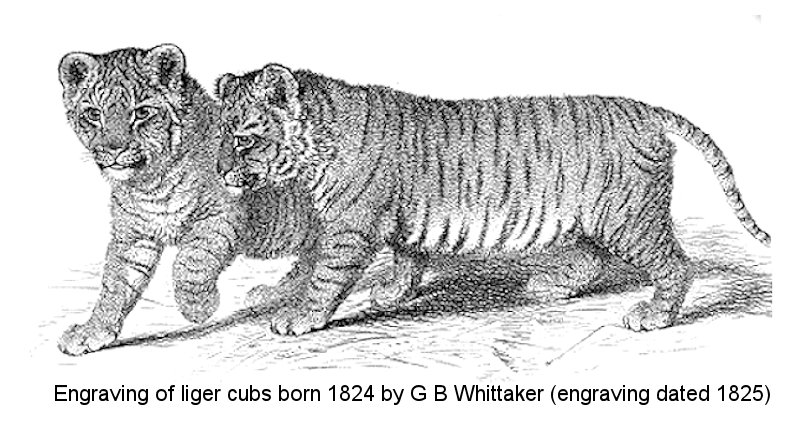
Cuvier reported a litter of three lion-tiger "mules" born in October 1824 in England to an African lion and an Asiatic tigress owned by Mr Atkins, an itinerant exhibitor and animal dealer. They shared a den and were observed to mate frequently during the previous July. The cubs were born at Windsor and were shown to his Majesty. They were taken from the tigress shortly after birth and fostered onto bitches and a goat. Cuvier presented an engraving of 2 of the 3 the cubs at 3 months old and observed that they would probably reach maturity. He described them as being dirty-yellow or "blanket-colour" (i.e. camel colour) with darker tiger-like stripes on the body and spots on the head and on parts of the body. They had lion-like heads. These appear to be the first recorded ligers.
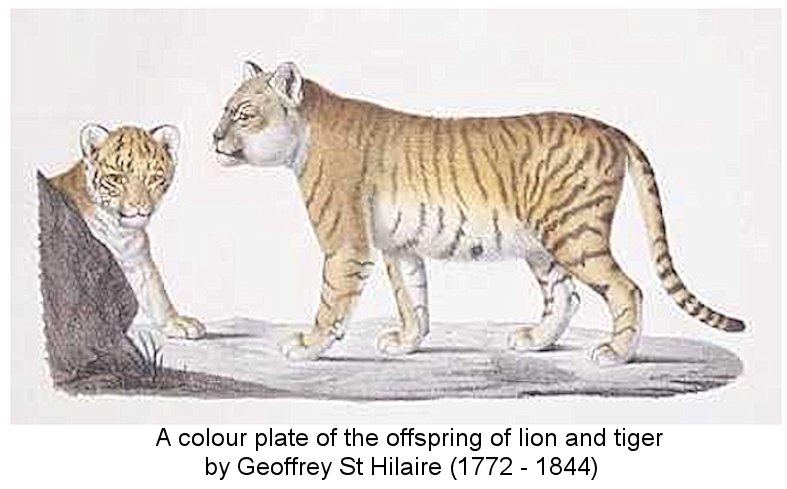
Elsewhere, it was reported that H Smith bred ligers from a Persian (i.e. Asiatic/Indian) lion and a "king tiger" (Royal Bengal tiger), which were born at Windsor on 17 October, 1824 though these could be the same hybrids that Cuvier reported. In 1888, Fitzinger recorded H Smith's hybrid of tiger and Persian lion at Windsor in 1824. He also described 4 sets of hybrids between a Barbary Lion and Indian tiger in the years 1827, 1829, 1833 and 1838.

[1827-BRED] HYBRID BETWEEN THE LION AND TIGER. (The Field, 20th April 1895) SIR WILLIAM JARDINE has figured a hybrid between the lion and the tiger, a litter which were whelped in Mr Atkin's menagerie in 1827. Their colour is described as being brighter than that of the lion, and the bands as better marked than they generally are in young lions. These hybrids are said to have all died when quite young, but this statement must have been made in error. I was lately at Salisbury, and in the museum there saw an animal which I took to be a panther or leopard, the skin of which seemed to have been destroyed by moths. The superintendent told me that it was a hybrid between the lion and tiger, which had been born in Edinburgh and died at Bedford, and was recognised by Mr Atkins, son of the original proprietor of the menagerie, as being from the collection of his father, and that it was between two and three years old when it died. The skeleton of this animal is also in the museum. I took the measurements of the stuffed animal, and found from muzzle to root of tail 5 ft 1-and-a-half inches, tail 2ft. 4in., height 2ft 4-and-a-half inches. The appearance of the animal was that of a panther ; the hair was a good deal worn off in places, apparently owing to its poor condition at the time of its death, but looked as if it had originally narrow stripes along the body, which were not continuous. The prepotency of the tiger in the shape and general appearance was very marked. I was told that the skin had in no way deteriorated, and that the many [mangy] condition existed when the animal was received at the museum. SMOOTHBORE
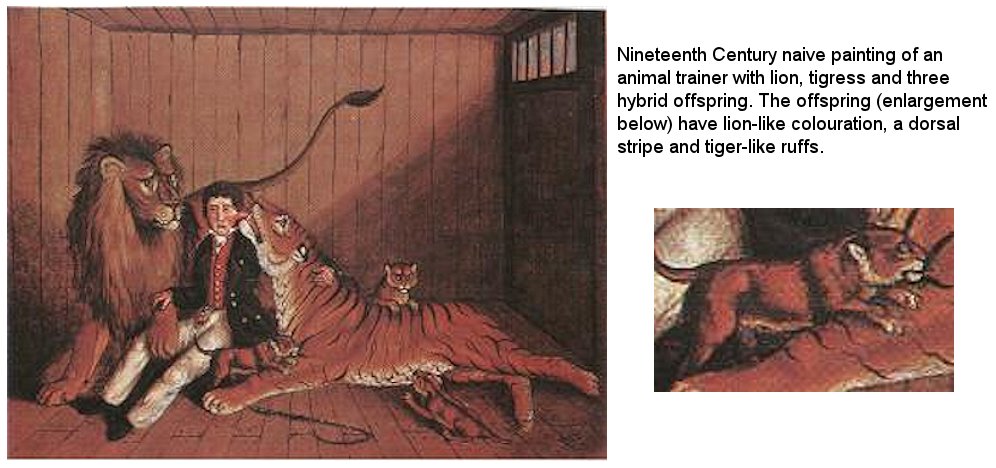
A definitive account of the Atkins hybrids, with dates of litters, comes from "Lloyd s Natural History", edited by R Bowdler Sharpe LLD, FLS &c. A Hand-Book to the Carnivora. Part I. Cats, Civets and Mongooses by Richard Lydekker, BA, FRS, Vice-President of the Geological Society etc, etc, etc. (Published 1896) . Page 45: Lion-Tiger Hybrids:
Although there is no record that such cross-breeding occurs in a state of nature; Lions and Tigers will occasionally breed together in captivity; but it is remarkable that the only recorded instances of such interbreeding took place between a single Lion and a Tigress. Attempts have, indeed, recently been made in the Zoological Gardens at Dublin, where, as mentioned above, Lion breeding is carried out with remarkable success, but hitherto without any successful result. The history of these hybrids has been very carefully worked out by Professor Valentine Bail, Director of the Science and Art Museum, Dublin, from whose papers the following account is taken. The parents of these hybrids were in a travelling menagerie owned at first by Mr. Thomas Atkins, and subsequently by his son Mr. John Atkins; and a total of six litters of hybrids were produced between the years 1824 and 1833. The parent Lion was bred in the menagerie from a Barbary Lion and a Senegal Lioness; while the Tigress was born in the collection of the Marquis of Hastings at Calcutta, and was purchased when about eighteen months old from a ship s captain, to whom she had been given by her original owner. Being of the same age as the Lion, she was placed with him in the same cage ; and in the course of two years proved to be in cub. The following is a record of the six litters produced by the union of this pair.
First Litter. Born October the 24th, 1824, at Windsor, and comprising two males and a female. They were nourished by a female terrier, but all perished within a year of their birth. These cubs were exhibited to King George the Fourth, at the Royal Cottage, Windsor, on the final of November, by whom they were christened Lion-Tigers.
Second Litter. Born April 22nd, 1825, at Clapham Common; there were three cubs, sexes not recorded. Reared by the mother, as also were all the subsequent litters. They only lived a short time.
Third Litter. Born December 31st, 1826 or 1827, at Edinburgh; one male and two females . Mr. Ball states that the year is given as 1827 in the handbill of the menagerie from which he quotes, and the other references seem to support that date; but Mr. John Atkins says it is given as 1826 in a printed catalogue in his possession. These only lived a few months. The skin of one of them, forming the subject of Plate III,, is preserved in the Science and Art Museum at Edinburgh, and a second is in the British Museum. Sir William Jardine remarks that the colour was brighter than that of the Lion, and the bands were better marked than they generally are in the young of tire true breed. Indeed, from his figure, the animal has more the appearance of a Tiger than of a Lion. Writing of the cubs of the first litter in the Library of Entertaining Knowledge, where one of them was figured, Griffith observes that "our mules, in common with ordinary Lions, were born without any traces of a mane, or of a tuft at the end of the tail. Their fur in general was rather woolly; the external ear was pendant towards the extremity; the nails were constantly out, and not cased in the sheath, and in these particulars they agreed with the common cubs of Lions. Their colour was dirty yellow or blanket-colour; but from the nose over the head, along the back and upper side of the tail, the colour was much darker, and on these parts the transverse stripes were stronger, and the forehead was covered with obscure spots, slighter indications of which also appeared on other parts of the body. The shape of the head, as appears by the figures, is assimilated to that of the father (the Lion) ; the superficies of the body on the other hand is like that of the Tigress.
Fourth Litter: Born October 2nd, 1828, at Windsor; one male and two females.
Fifth Litter: Born May, 1831, at Kensington, three cubs, sexes not recorded. They were shown to the Queen, then Princess Victoria, and to the Duchess of Kent. The whole group performed in a specially constructed cage at Astley s Amphitheatre, and in 1832 were taken by Mr. Atkins for a tour in Ireland
Sixth Litter. Born July 19th, 1833, at the Zoological Gardens, Liverpool; one male and two females. One, the male, lived for ten years in the Gardens. The young male Lion-Tigers when about three years old had a short mane, something like that of an Asiatic Lion; and the stripes became very indistinct at that age.
Mr. J. Atkins informed Professor Ball that there was a badly stuffed specimen of one cub which was about a year old in the Museum at Salisbury ; and there is another in the Cambridge Museum. From an account quoted by Mr. Harmer it would seem improbable that that that particular specimen, had it survived, could have bred. As a matter of fact, it appears, indeed, that none of the cubs ever did breed, though there is no known reason why most of them should not have done so. Mr. Atkins thinks that the cubs of the earlier litters died from overfeeding, as when he adopted a different treatment he had no difficulty in rearing them.
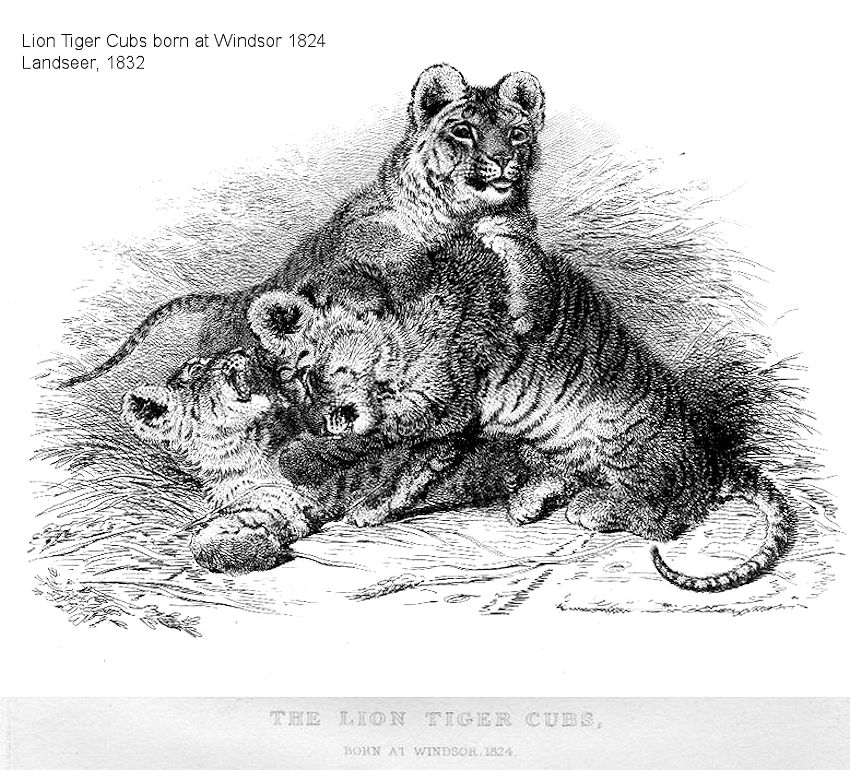
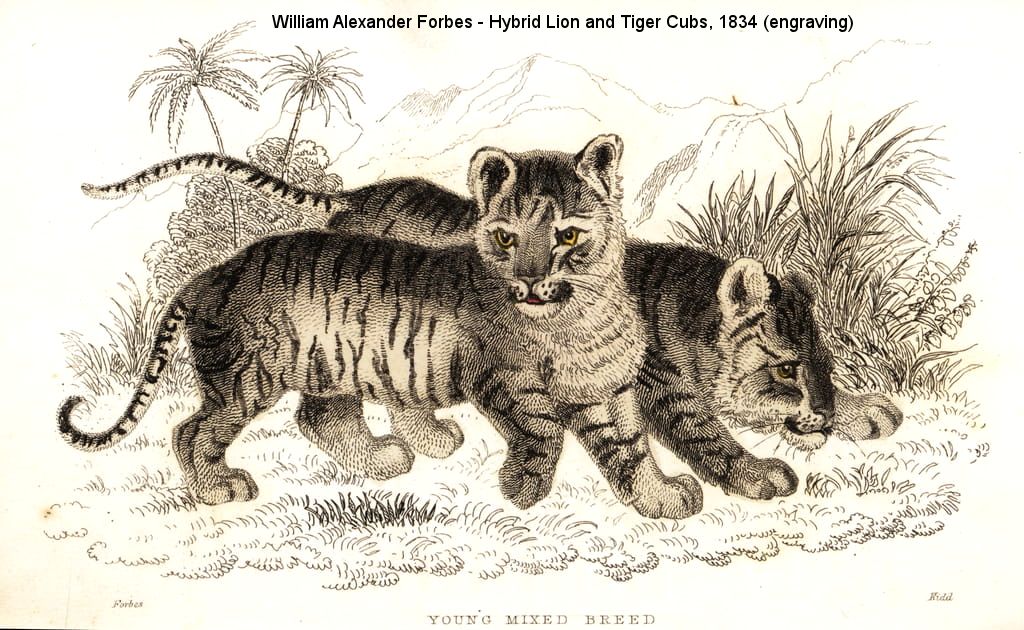
In 1830 (according to the South Eastern Gazette of 24 August 1830) Wombwell s menagerie exhibited a black leopard in the same den as a lion-tiger and a leopard.
Two liger cubs were born in 1837. These were exhibited to His Majesty William IV and to his successor Queen Victoria. On 14th December 1900, Carl Hagenbeck wrote to zoologist James Cossar Ewart with details and photographs of his cross breeding experiments using a lion and a tiger born at the Hagenpark in Hamburg in 1897. He wrote that he was also attempting to cross a female leopard with a Bengal tiger. On 31st May 1901, Hagenbeck wrote again to James Cossar Ewart sending him photographs of the results of his male lion and tigress hybridisation experiments.
The Bendigo Independent, Victoria, 12 Aug 1893: An Attempt to establish 'a cross breed between (he lion and tiger is being made by the Royal Zoological Society of Ireland. Such hybrids have been known, an English showman having had a litter of three lion-tiger cubs born in 1824, and a second of two cubs in 1827. One of these whose skeleton and stuffed skin now belong to the University of Cambridge lived about six years.
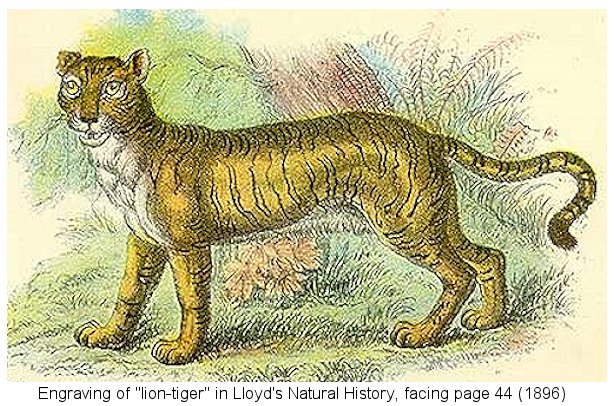
The Globe, 19th June 1902 carried a short piece about Hagenbeck s lion-tigress hybrids: LION-TIGER HYBRIDS. A SUCCESSFUL EXPERIMENT. Although the possibility of breeding lion and tiger hybrids in captivity has long been known, the results of the experiments have not been very successful, the animals rarely reaching to their full size and development. More recently, says Mr. W. B. Tegetmeier, in the." Field, my friend Mr. Hagenbeck has obtained some extraordinary results, and has supplied me with particulars. The article is illustrated with some excellent photographs. One is of a mature animal which was born on May 11, 1897, it is now rather more than five years old. It is male. Its height across the withers as stands erect is 45in., English measurement. Its length from the nose to the tip the tail is 10ft. 2in., a length which exceeds that of a full-grown lion. In May during the present year it weighed 220 kilos., equal to 467 English pounds. It is an exceedingly fine, well-grown animal, showing slightly the stripes of the tiger, but it is not furnished with a mane like a lion, and this appendage usually appears in the lion when three years old, it may be presumed that no mane will ever be present in the hybrid. Mr. Hagenbeck has not yet succeeded in rearing any offspring from it. This animal is described by him as larger in size than any lion or tiger. He speaks of it as monster, and says that the two young ones, which are now only thirteen months old, are larger than any pure-bred lion or tiger of the same age, and he thinks, if they progress satisfactorily, they will grow to greater size than the large male. The two younger ones, which were a year old on the 28th of last April, are both males, and show the tiger markings rather more distinctly than the older animal. In addition to these photographs, Mr. Hagenbeck has sent me another of two young lion and tiger hybrids, male and female, born April 20 in the present year, twelve months after the birth of those reproduced. It shows the two little ones lying across a small terrier, which has furnished them with a small supply of milk, the remainder being given to them by a bottle. This same terrier was the nurse for the two larger ones. These animals, thus bred in what may be termed domestication, become exceedingly tame and docile, as may be inferred from the statement made above.
From the Indianapolis News (4th April 1903) we learn that the first hybrid is named Prince. The Rolla Herald (11th August, 1904) adds a couple more details, referring to two monster cross-bred cubs of Roland, a magnificent Barbary lion and Kitty, a Royal Bengal tiger. The Dayton Herald (2nd November, 1910) elaborated on Hagenbeck s lion-tiger breeding and the success rate: Carl Hagenbeck now proposes to breed wild animals at his wild animal farm in Hamburg, and to furnish the zoos and parks of the world, not merely by sending forth hunters to capture wild animals, but by actually raising them in Germany. Already we breed lions and tigers, said Mr. Hagenbeck, You saw Sawade s tiger, Alexander, a splendid strong beast. She has borne about thirty hybrid beasts, lion-tigers, fathered by the lion Nero. I m sorry to say we only succeeded in bringing up four of these hybrids, but we can do better now. There are the four, in those cages, three males and a female. Interesting, aren t they? Interesting they certainly were, great powerful brutes, more like lions than tigers, but without fine manes or markings, and, on the whole, scarcely an improvement on nature s model, yet vastly important as suggesting wonderful results that may be obtained by a blending of wild races.
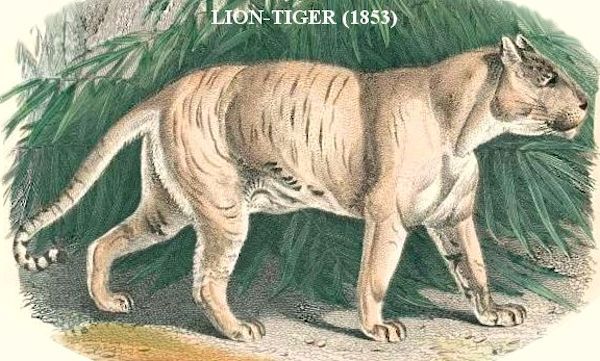
In his Illustrated Natural History (1853, 1874) the Rev JG Wood wrote: Dissimilar as are the lion and Tiger, there has been an example of a mixed offspring of these animals, the lion being the father and the Tigress the mother. The lion had been born and bred in captivity, and the Tigress bad been captured at a very early age, so that the natural wildness of their character had been effaced by their captive life, in which they felt no need to roam after. living prey, as their daily sustenance was always forthcoming. It has already been mentioned, that the young of the lion are marked with faint stripes of the tigrine character. Similar streaks were observed on the fur of the Lion-Tiger cubs, but they were darker than those of the lion cub, and were permanent instead of vanishing as the creature increased in years. The shape of the head was like that of the lion, while the contour of the body resembled that of the Tiger. These curious little creatures were too valuable to be entrusted to the care of the mother, and therefore were removed immediately after birth, and placed under the fostering care of a goat and several dogs. Under this treatment they throve well, but did not reach maturity. This is not the only instance of a hybrid breed between the lion and Tiger.
Prince s background and temperament is described in more detail in HYBRID LION AND TIGER (The Los Angeles Times, 27th July, 1902.): Strange Animal Born In Captivity and Now on Exhibition at the Cincinnati Zoo. [Cincinnati Enquirer:] One of the most interesting features of the exhibition of trained animals at the Zoo is a strange-looking beast, which forms the center of all the pyramids and positions Into which the animals are formed on the stage, and is accorded the place of honor on all occasions. This is nothing more than might be expected, when it is known that this is the only hybrid of its kind in the world. The father or this strange animal was a lion and the mother a tiger, both of whom have been in the possession of Hagenbeck from the time that they were cubs, having been born in the Hamburg collection. These two cubs, the one a lion and the other a tiger, were caged together from infancy, and were not allowed to even see other animals of either the lion or the tiger kind.
The hybrid now at the Zoo partakes of the appearance and the characteristics of both a lion and a tiger. It has a lion s mane and a tiger's sharp ears, while its face is much more like a lion than it is like a tiger. On its sides the heavy hair is striped like that of a tiger, and its body from the fore legs back is more like that of a tiger than of a lion. In characteristics it is rather more gentle than some lions, and certainly was found to be more easily trained than many tigers. It was found, however, to be somewhat whimsical under the trainer s hands, and for a long time it was feared that it was going to be a most treacherous beast. Herr Boger, however, succeeded in bringing the animal around, until it is now one of the brightest and most docile in the lot.
There are a great many people who do not believe when first told that such a thing as a cross between a lion and a tiger is possible. A single look, however, at the animal in the Zoo will be convincing evidence that such a step aside in nature is possible, and in this case has been realized. The value of the cross is the better appreciated when it is known that it is the only one now living out of eleven that were born at different times. This one has been exhibited in the group of which it is a member for a few years. Prince, for that is his name, is but five years old, but he has attracted more attention than almost any other animal that ever came into the world. He has been exhibited before the Emperor of Germany, the Czar of Russia, the Queen of England (who was then the Princess of Wales,) the King of Saxony, and many other potentates and nobles of Europe. Herr Boger, the trainer, said that while in England with the group, Prince was everywhere greeted with the greatest curiosity. Herr Boger was asked if he had ever been seen by the King of England.
No, replied he, While we were in England the King, then Prince of Wales, was not a spectator at the exhibition, the excuse being made that he was too busy. Prince was a hard animal to train, said Boger. Sometimes i was afraid that he would never be brought to his right senses. I kept at him, going over his lessons carefully and repeatedly, and finally he came around all right, until now he is one of the best and easiest-managed of all. Mr. Hagenbeck thinks a great deal of this animal. He has done a good deal of animal breeding, and is prouder of this one than of anything else that he has. When the animal was finally trained to do his part in the show, Mr. Hagenbeck expressed great satisfaction. He is a wonderful animal, and no value could be placed on him when it cornea to measuring his worth by money. Just think of it! An animal that is different from anything else in the whole world. Neither a lion nor a tiger, and yet like both. You can t blame Hagenbeck for liking him. And Herr Boger reached through the bars of the cage and rubbed the shaggy mane and head of Prince, as he lay stretched out on the floor.
A full description of Hagenbeck s first three surviving lion-tiger hybrids appeared in Animal Life and the World of Nature A Magazine of Natural History (1902), p200 202, in the article LION-TIGER HYBRIDS - By H. A. Bryden.
HYBRIDS from the mating of lion and tiger are by no means common. In the wild state they are unheard of, although in parts of Asia these animals were, and still are, occasionally found in the same haunts; and even in captivity, where cubs from the coupling of the two species have been produced, these mixed offspring have been usually poor specimens, very difficult of rearing. It has remained for one of the most enterprising collectors and naturalists of our time, Mr. Carl Hagenbeck, not only to breed, but to bring successfully to a healthy maturity, specimens of this rare alliance between those two great and formidable felidae, the lion and tiger. The illustrations will indicate sufficiently how fortunate Mr. Hagenbeck has been in his efforts to produce these hybrids. The oldest and biggest of the animals shown is a hybrid born on the 11th May, 1897. This fine beast, now more than five years old, equals and even excels in his proportions a well-grown lion, measuring as he does from nose to tip of tail 10ft. 2in. in length, and standing only three inches less than 4ft. at the shoulder. A good big wild lion will weigh about 400lbs. Mr. Selous gives the length of a lion shot by himself as 9ft. 11in., its height as 3ft. 8in., and its weight as 4101bs. and it is probable that in exceptional cases lions may attain 450 and even 500lbs. But the hybrid in question, weighing as it does no less than 467lbs., is certainly the superior of most well-grown lions, whether wild-bred or born in a menagerie.
This animal shows faint striping and mottling, and, in its characteristics, exhibits strong traces of both its parents. It has a somewhat lion-like head, and the tail is more like that of a lion than of a tiger. On the other hand, it has little or no trace of mane. It is a huge and very powerful beast, but, like most of Mr. Hagenbeck's feline pets, has been reduced to a state of comparative tameness, taking part in the shows given by a keeper, with other felidae, such as lions, tigers, leopards and pumas, not to mention dogs and various species of the genus Ursus.
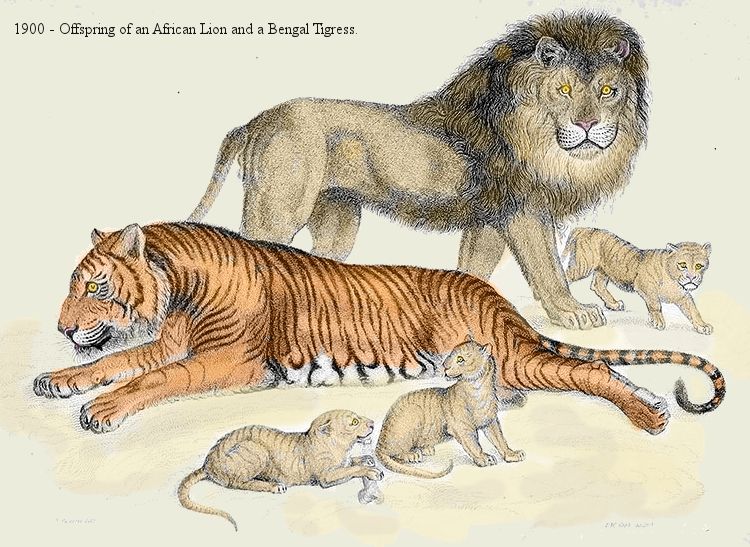
The next hybrids are a pair born, like the bigger animal, of lion father and tigress mother. They are about seventeen months old, having been born on the 28th April, 1901. They show far more of the tiger striping than their elder relative, and are altogether much more tiger-like in appearance. At the age of twelve or thirteen months when photographed they were already as big as most full-grown lions and tigers, and they promise to develop into enormous specimens of the great cat family. They are, apparently, although reduced to a certain state of tameness, none too sweet tempered, judging from their photographs. The small photograph supplied by Mr. Hagenbeck shows another pair of hybrid cubs mere babies, born in April of the present year and photographed a few weeks later. They lie with their foster-mother, a fox terrier, whose services had to be called in for the purpose of rearing them. They, too, show strong traces of striping; but as lion cubs in extreme infancy show a good deal of marking also, chiefly spots and blotches, it is possible that these stripes may to some extent disappear as they approach maturity.
These experiments of Mr. Hagenbeck are extremely interesting, but, whether fortunately or otherwise, it is almost certain that the breeder of these strange crosses between lion and tiger will never succeed in perpetuating a race of feline mules. Hybrids are notoriously infertile, and although mares the mules of horses and asses have strong maternal instincts, and will even develop milk and suckle young foals, which they manage to decoy away from their true mothers, there is, I believe, no genuine recorded instance of such a mule bringing forth offspring of her own. Already, I understand, Mr. Hagenbeck has mated the big lion-tiger hybrid with other pure-bred felines, but with no result. Darwin long since pointed out, in his " Origin of Species," that " hybrids raised from two species which are very difficult to cross, and which rarely produce any offspring, are generally very sterile." That assertion seems to be borne out strongly by the present case, and it seems altogether unlikely that any perpetuation of this new kind of fancy stock is to be looked for. Nor, indeed, is it desirable. In their own wild habitats, and after their own fashion, lions and tigers are necessary and very splendid creatures. A bastard strain from the crossing of these two species is not in the least likely to add to the beauty of the wildernesses of Africa or Asia or to the usefulness of two necessary forms in the scheme of nature. Nor in civilized countries, beyond the mere fact of producing a "sport," or curiosity, are these hybrids likely to be of interest or of use to anyone. In this case, at all events, nature seems to have wisely set limits which even the ingenuity of man is not likely to be able to evade. The causes of the sterility of first crosses and of their hybrid progeny were subjects that puzzled even that profound thinker and enquirer, Darwin. He arrived at the conclusion that such sterility had not been acquired by natural selection. "In the case of hybrids," he says, "it (sterility) apparently depends on their whole organisation having been disturbed by being compounded by two distinct forms; the sterility being closely allied to that which so frequently affects pure species, when exposed to new and unnatural conditions."
Hagenbeck s hybrids were great curiosities in both Europe and North America. The Washington Times, 4th January, 1903 reports on Hagenbeck at the Lafayette. The principal feature is a mixed group consisting of two lions, three tigers, two pumas, two leopards, two polar bears, five Stuttgart hounds, and the much-talked-of Hagenbeck hybrid. This curious animal is a cross between a lion and a tiger, the first one ever brought to this country. It has the general appearance of the lion but the markings of a tiger. There are said to be only two other beasts of this description in the world, one being in the possession of the London Zoological Society and the other in the Hagenbeck depot in Hamburg. Various newspapers published the following report in early 1903: The most interesting cross-breds at the depot are those of lions and tigers. One of these strange animals [Prince] has been taught to do some stage tricks, and is now performing with others in one of Mr. Hagenbeck's groups of trained animals. He is 3 years old, and is a fine creature. He weighs nearly five hundredweight, measures ten feet from the tip of his tail to the tip of his nose, and stands four feet high up to the top of his shoulders. The peculiarity of this beast is that it has a tiger s body and a lion s head. His father was a Senegal lion and his mother a Bengal tigress. " The Music Hall and Theatre Review (26th August, 1904) gives us an idea of the value of such a hybrid: MR. HAGENBECK exhibits at St. Louis the famous pair of lion-tiger hybrids, for which he has been offered 1,000. These animals are the largest carnivora the modern world has ever seen. A full-grown male lion weighs 350 lbs., but Romulus and Remus, though now only four years old, weigh 500 lbs. apiece, and will probably be still heavier when full grown. Sadly Hagenbeck s zoo suffered dreadfully in the First World War and his big cat hybrids perished.
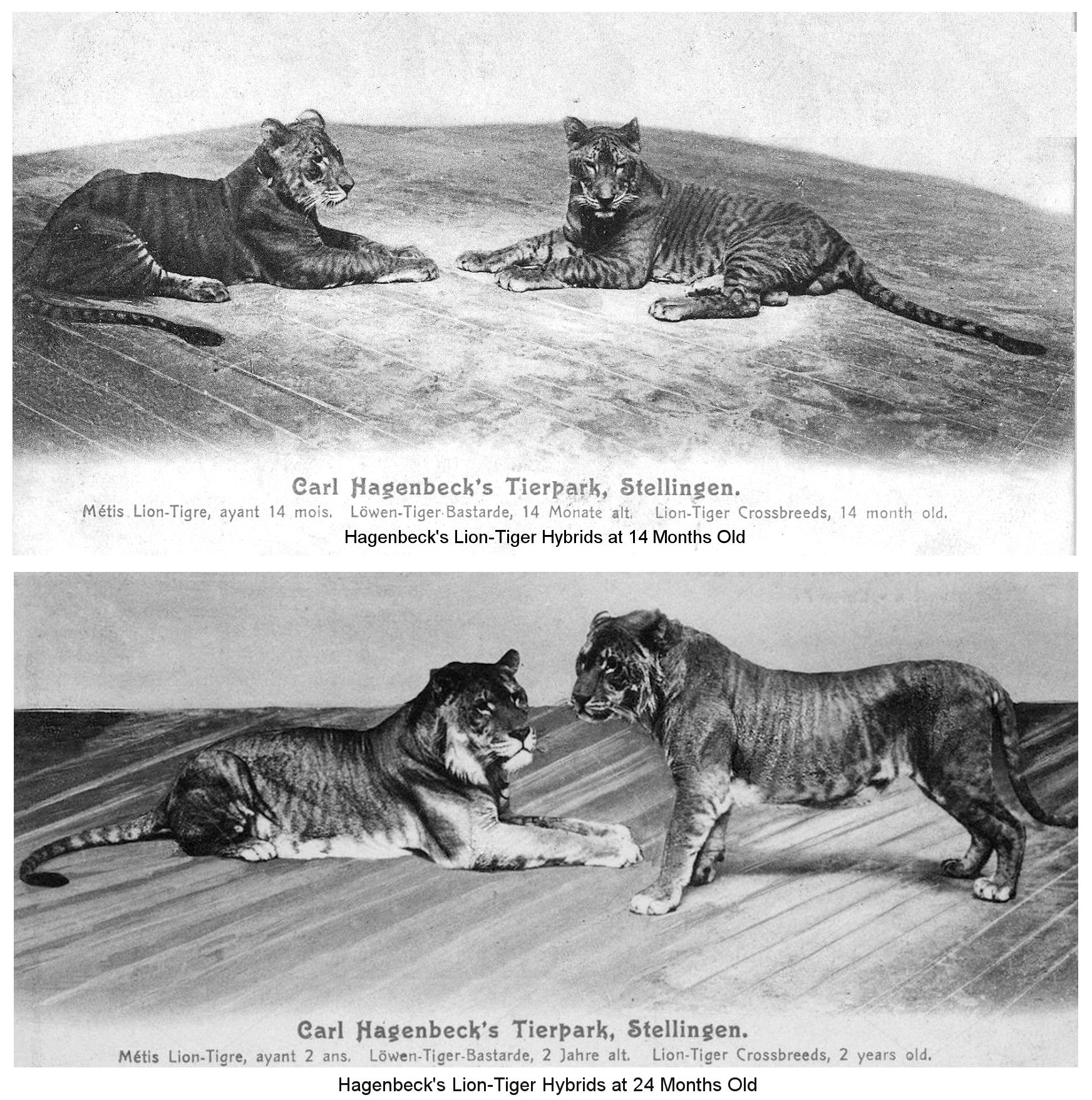
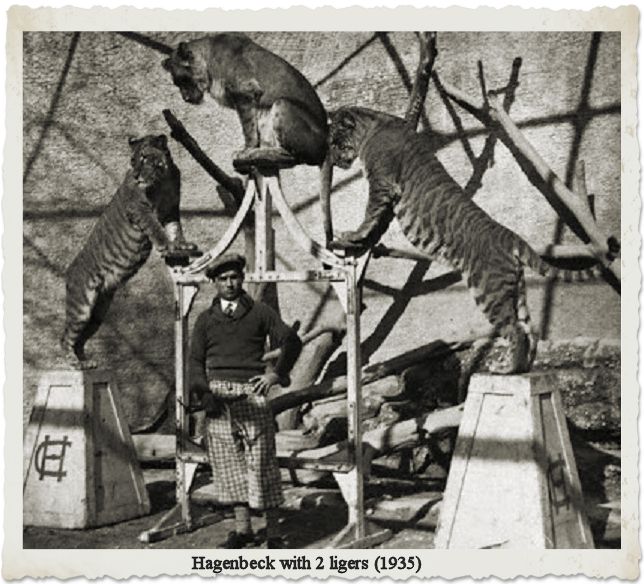
Remarkable Hybrid Animals (various, May 1903). That entirely new species of animals may be created is demonstrated by the latest achievements of the world s greatest animal hunter, Carl Hagenbeck. After a lifetime of study he has brought into existence a monster creature that has no place in natural history, yet is the offspring of a Senegal lion and a Bengal tiger. On his animal ranch, near Hamburg, Germany, Hagenbeck has for some time past been devoting himself to the creating of new species of animals and birds. A strange creature, the offspring of a leopard and a puma, is now in the Berlin Zoological garden, but of all these the nameless monster now in his gardens at Stellingen is the most wonderful. From the time Hagenbeck began hunting wild beasts in India and Africa he wondered what sort of beast the two fiercest animals on earth would produce if they could be made to breed together. In order to try the experiment, several years ago he secured a splendid specimen of the Senegal lion and a monster Bengal tigress. Eventually the new monster, which is with the Hagenbeck trained animal show, was born. It is now larger than either the tiger or the lion, and does not seem to have reached its full growth. From the nose to the tip of the tail the lion-tiger measures 10 feet 2 inches, which is a greater length than that of a full-grown lion. When it stands on all fours its height to the shoulders is 4, feet. Its weight is 467 pounds. The body of the animal shows the stripes of the tiger, but its head is that of a huge lion, except that it has no name. Yet in the face of its mammoth proportions and fierce aspect, the disposition and animal instincts of the beast are more like those of a dog than either of the two fierce wild animals of which it is the offspring. Even to other animals it shows a remarkably mild nature. It possesses a great fondness for human companionship, and takes great delight in being fondled and made much of than is characteristic of wild animals in general. But this is only one, perhaps the greatest, of the marvels which the famous naturalist had brought about.
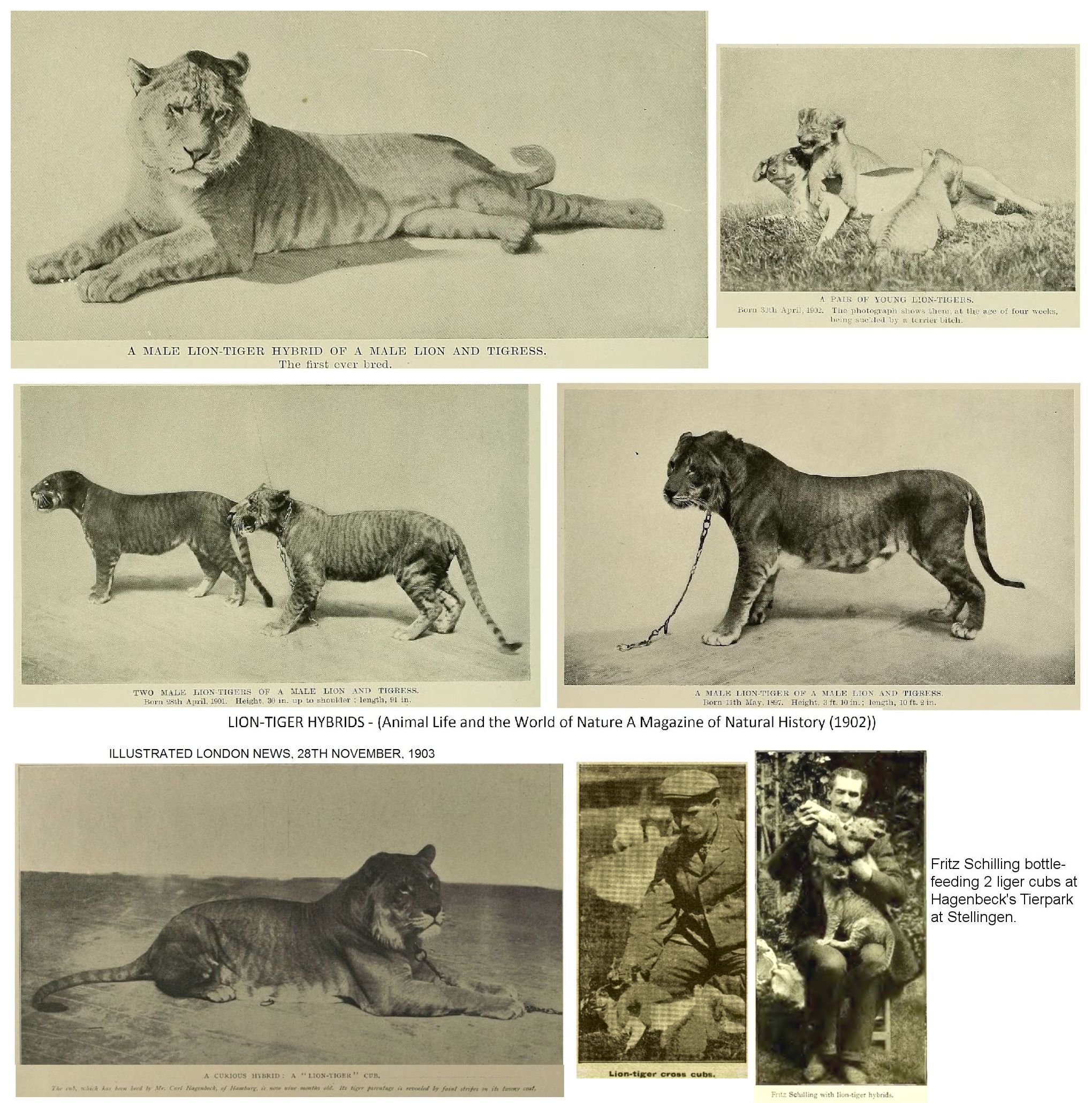
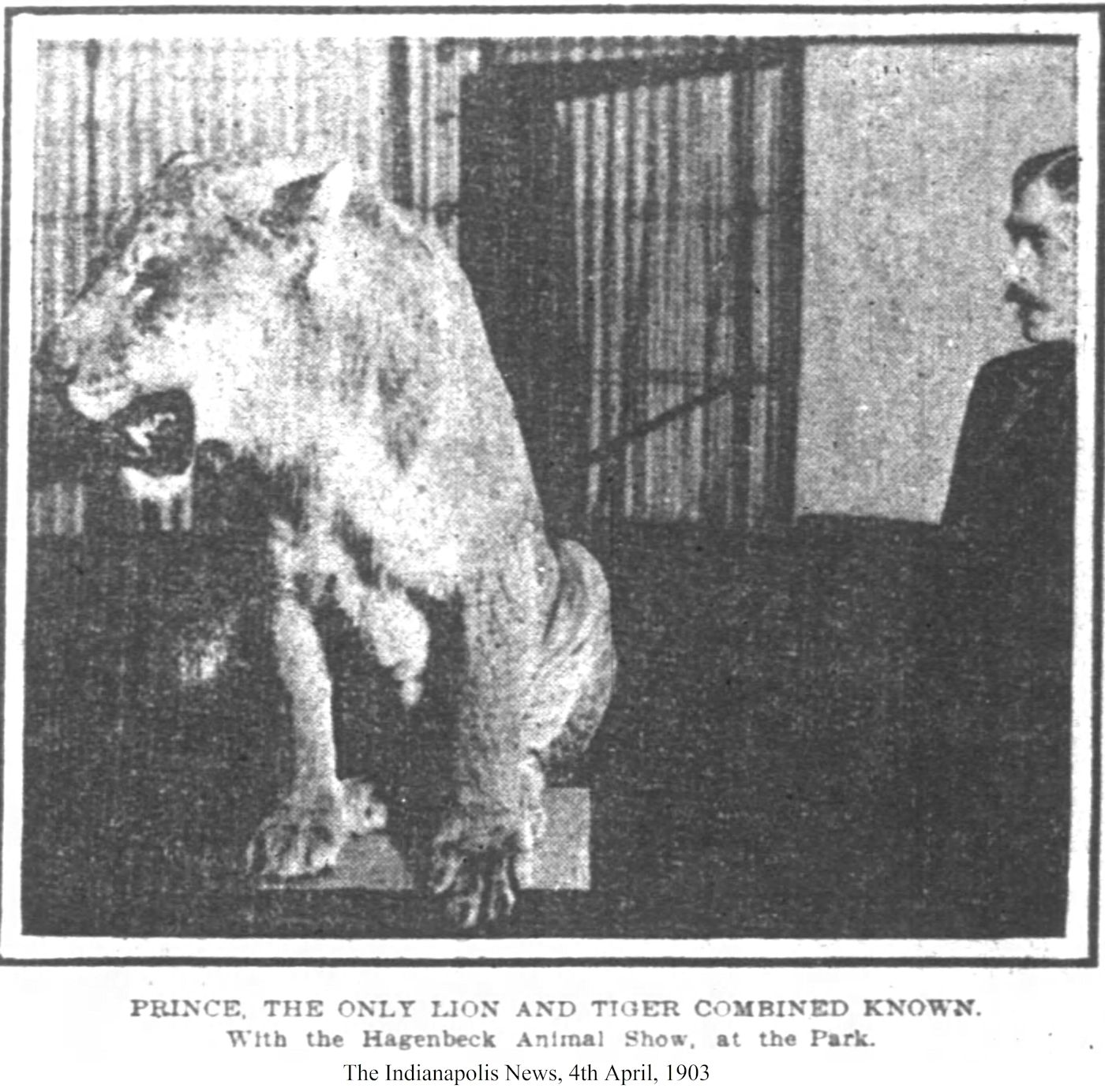
Hagenbeck was not the only person breeding hybrids. These had become popular circus and mengaerie attractions in the USA and proprietors tried to outdo each other with their lion-tiger hybrids and other big cat crosses.
FIGHT AT BOSTOCK S. The Buffalo Times (New York). 13th September 1901, pg 10.
Trouble Arose Over Food and Hybrid Cub Tore His Sister in Pieces. The baby hybrid, part lion, part tiger, born at Bostock show May 20th, now four months old, got into a fight last night. The trouble began over a piece of meat which both wanted. Neither would give way and a lively scrap was on in a moment. They fought a fight to the finish. Finally the male hybrid caught his sister cub by the throat and tore her to pieces. Hybrids are the most dangerous animals in existence, as they combine the bloodthirstiness of the tiger with the savage ferocity and strength of the lion. (This was remarked upon by Ellen Velvin in her book "Behind the Scenes With Wild Animals" (1906): "Hybrid cubs appear to be the most aggressive, savage little animals. I saw some fine young hybrids at Barnum & Bailey's show at one time - the result of mating lion and tiger - who were constantly fighting without cause or reason, evidently simply for the pleasure of fighting. This seems rather curious, as when lion and tiger cubs are put into the same cage there seems no particular disposition to fight. In the Dublin Zoological Gardens two lion cubs and two tiger cubs lived for some time in the same cage without the slightest sign of ill-will."
St Louis Replublic, May 8, 1904: LION-TIGER HYBRIDS INTEREST-SCIENTISTS. Paris, May 7, 1904 (various) A recent event in the animal kingdom, the first of its kind so far as France is concerned, has been attracting scientific as well as popular interest at Bostock's hippodrome lately. This was the birth of two baby hybrids, the proud father being a magnificent lion and the mother a large Indian tigress. Strange to say, the she cub takes after the father, as far as coloring is concerned, while the little brother favors the mother.
[LION, TIGRESS HYBRID] The Evening Herald (Fall River, Massachusetts), 16th August 1904, pg 4.
Baltimore the lion who recently attacked at seriously injured Capt. Bonavita at Bostock s Dreamland, Coney Island, is the father of a cub bon of a tigress and now on exhibition at Bostock s. The cub has been named Hybrid, and resembles a lion much more than a tiger, though plainly marked. Such hybrids, while not altogether unknown, are very rare in menageries, said Mr. Bostock, and I have never known of a lion and a tigress mating in a wild state. The offspring of such mating is usually short-lived, and, though this cub seems healthy enough, I doubt if he will reach maturity.
FIERCE CREATURES AS CHUMS. The Times (Independence, Kansas), 30th June 1905, pg 8.
Group No. 1 in The Carl Hagenbeck Trained Wild Animal Show which comes to instruct, amaze and amuse us, in Independence Wednesday, July 12, comprise the largest number of different species ever seen in a mixed assemblage . . . a monster Hybrid Lion-Tiger, four years old, and a magnificently majestic creature, powerfully and symmetrically combining the physical peculiarities of either species, and wearing the tiger s stripes upon the lion s skin. On earth its like was never seen before.
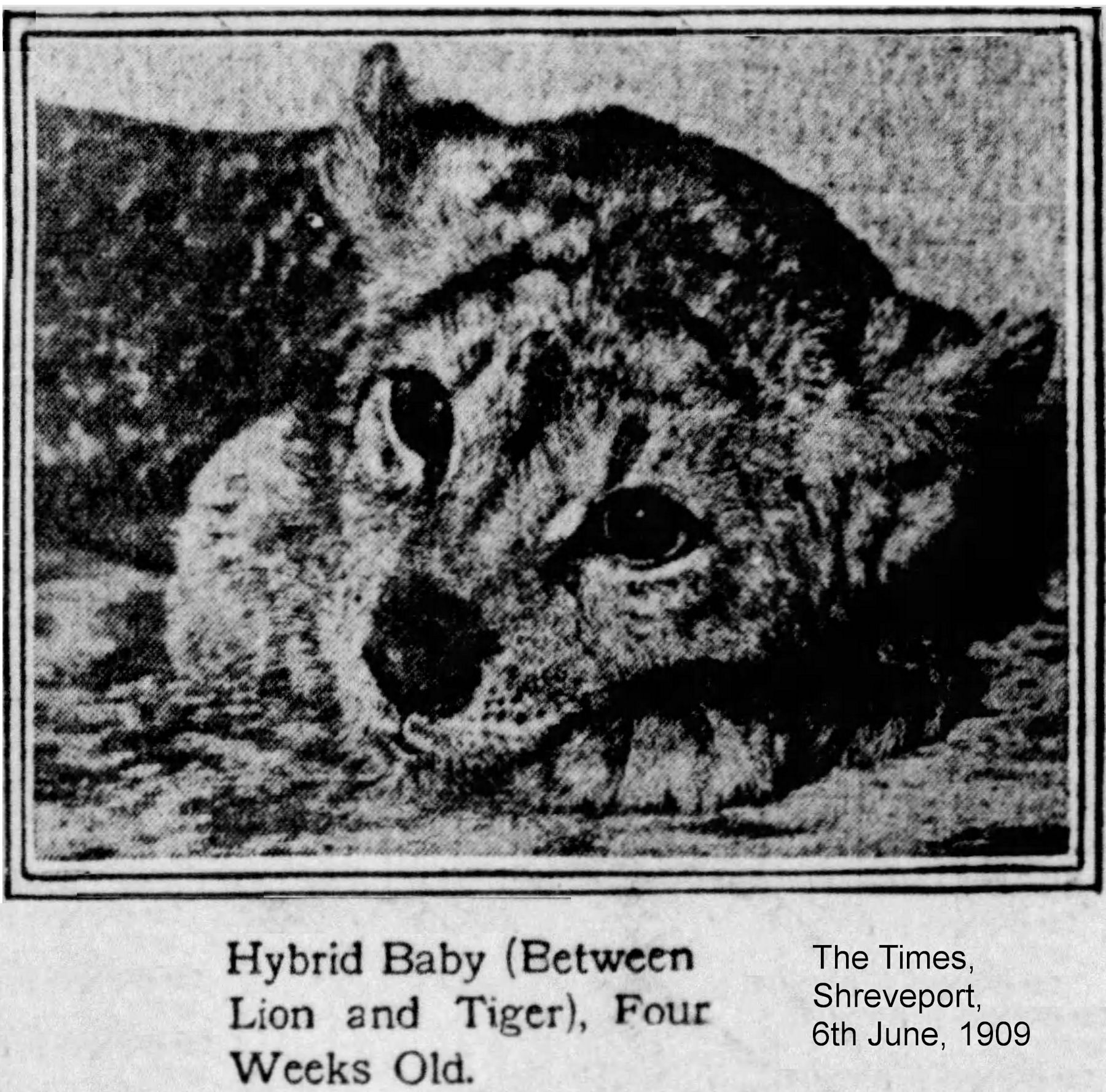
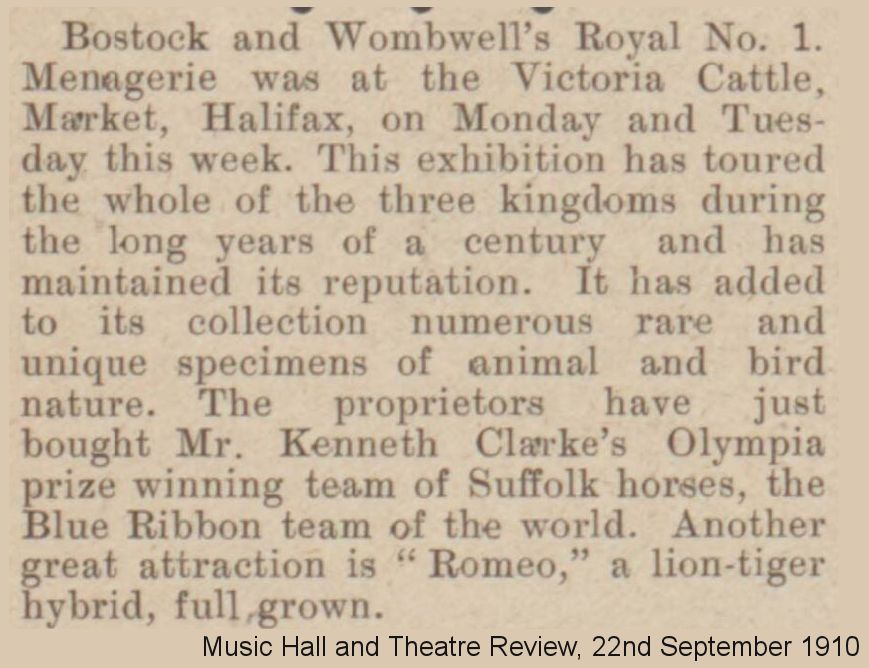
Although Hagenbeck s hybrids had gone, others were crossing big cats. The Aberdeen Press and Journal, 24th June 1924 tells us of a lion-tiger hybrid bred in India: LION-TIGER HYBRID. No more remarkable animal has ever been exhibited in the Zoological Society's Gardens, London, than the full-grown lion-tiger hybrid that arrived at the Regent s Park menagerie on Saturday morning. The animal, bred in India, on the estate of H.H. the Maharaja Jam Sahib of Nawanagar. who has presented it to the Zoo, is huge creature, standing higher than either a lion or a tiger, and has a very large head, with a rudiment of a lion s mane. The head and legs are faintly striped. The father is known to have been a lion, and the mother a tiger. A similar cross was exhibited in Hagenbeck's menagerie in Hamburg about twenty years ago. The offspring then, as the present case, was of large size, and weighed much the two parents together.
LION-TIGER HYBRIDS (The Field, 30th June 1906) The hybrids bred between the lion (male) and tiger (female) in Atkins's menagerie are well known, as are those produced within the last few years in Mr Hagenbeck's menagerie. May I add, on the authority of Fitzinger, two other cases from the Continent which do not appear to be recorded in English literature? In August, 1833, a tigress threw a male and a female cub to a Barbary lion in Herr Polito's menagerie in Weimar. The male cub was killed by the dam, and the female lived for about nine months. The skin was stuffed, and, with two mounted lion cubs, exhibited in the menagerie. In general appearance the hybrid was more like a young lion than a tiger. Two cubs of similar parentage were born in Herr Kreutzberg s menagerie at Elberfeld in October, 1838. One a female lived but a few days: the male was suckled by a pug. and lived in the menagerie till 1851, when it succumbed to the effects of the severe winter. Fitzinger says that this was one of the few lion-tiger hybrids that had reached maturitv, for it was a little over thirteen years old. It is mounted in the lmperial Zoological Museum at Vienna. When about half grown the colour of the hybrid was yellowish-grey, with a brownish tinge on the nose, cheeks, and back. The forehead was marked with small dark spots, the hind limbs were striped with black, and on the posterior half of the tail were seven black rings, and the tip was dusky. By the time it reached maturity the appearance of the hybrid altered greatly, and it was scarcely to be distinguished from a Bengal tiger.
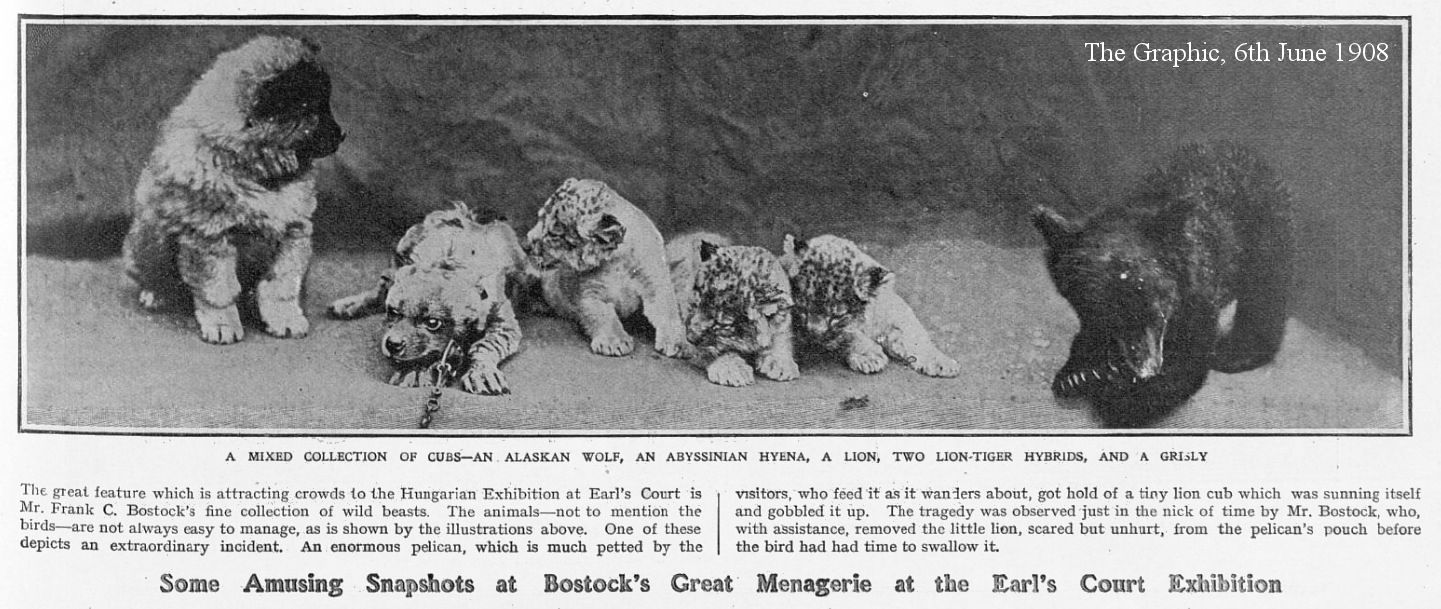
MORE FELINE HYBRIDS (The Field, 25th April 1908). Of menagerie-bred feline hybrids the most famous are the lion-tigers bred by Atkins in the first half of the last century. Their history was worked out by Professor Valentine Ball, and an excellent synopsis of his paper is given by Mr Lydekker in his volume on Cats in Allen's Naturalists' Library. Ten years was the greatest span of life In any of these hybrids, but one bred by Kreutzberg in his menagerie at Elberfeld lived to be a little over thirteen years old (Field, June 30, 1906, p. 1090). Mr Pocock has kindly informed me that the tigress which produced the lion-tigers in Atkins's menagerie is now In the Bristol Museum. Those bred by Carl Hagenbeck are also well known; they were described and figured in the Field (June 30, 1902), and two of them formed part of the Somali Village Exhibition at the Crystal Palace (Field, April 25, 1905, p. 720). HENRY SCHERREN.
LION-TIGER IS FREAK OF ANIMALS. Saskatoon Daily Star (Canada), 25th July 1924, pg 9.
London, July 22. An adult male liger or lion-tiger hybrid, bred at Newanaggar by the famous Indian cricketer, Maharaja Jam Saheb (Prince Ranjitsinhji) and presented by him to the Zoological Society, is on exhibition. The male parent was an African lion, the female a tigress, and the liger (no doubt it would have been called a tigon if the father had been a tiger) is about three years old. It is a healthy and active creature, graceful in its movements, and without the odd appearance of crosses; so that it deserves exhibition on its own merits, apart from its zoological interest. It stands high, being nearly 4 feet at the centre of the arched back, and has the restless gait of a menagerie-bred animal, but seems heathy and reasonably tame.
Although crosses in the second generation are known to follow laws from which some of their characters may be predicted, first crosses usually present a blend or mixture of characters, the exact nature of which cannot be predicted. The liger makes the curious shuffling noise of a tiger. The ground color is tawny, with the under parts and inner sides of the legs nearly white. There is a water-mark of stripes not much darker than the tawny hair visible only in good light, over the body, but conspicuous on the legs. These are definitely striped like the markings on tigers, in hoops around the body and in broken rings round the legs and towards the tip of the tail. The tail is long and slender, but ends in a large lion-like tuft of black hair. There is a small mane on the top of the neck, and a tiger-like beard round the chin. The insides of the ears are black, with a large white area, as in tigers. The head is rather long and narrow and the limbs, long in proportion to the body are more like those of a tiger.
Hybrids are fairly common among the large carnivores, although they are not known to occur in nature. Lion-tiger hybrids have been bred occasionally in Indian menageries. So far as can be ascertained, no living lion-tiger hybrid has ever been placed in London before, but in 1908 a dealer placed on deposit in the Zoo a strange animal in which the blood of lion, leopard and jaguar were stated to be mingled. But the history was obscure. There is no experience of the fertility of lion-tiger hybrids but crosses between polar bears ad brown bears have bred back wit brown bears. The external pattern and affinities are unsafe guides to the affinities of animals, and the lion and tiger are very closely allied. It is to be hoped that the male liger will live long enough to make an attempt at breeding him.
(The Illustrated Sporting and Dramatic News, 19th November 1927, describes this same animal as the offspring of a tiger and a lioness. It is described as aloof and unfriendly. Its parents later fought each other with fatal results. According to TIGONS AND LIGERS by Maurice Burton, D.Sc., in the Illustrated London News, 14th June 1952, the Zoo hybrid of the 1920's was the offspring of a tiger and lioness. Pocock described its mix of characteristics thus: The lion ancestry was shown in the presence of a mane, a nearly uniform, tawny-buff skin, with no sign of the orange ground-colour of the tiger, a small but distinct tail-tuft and only very faint stripes, no more distinct than seen in some East African lions. The tiger characters were seen in the shape of the head and body, the general absence of dark tips to the hairs (a characteristic of lions), an indistinct black dorsal stripe, a few thin dark stripes at the tip of the tail, and the ears being jet black, with a large tawny patch, instead of the usual white patch of the typical tiger, running to the outer edge near the tip of the ear. )
HYBRID LION-TIGER IS CHIEF OF GREAT ANIMAL SHOW COMING THURSDAY. The Casper Daily Tribune (Wyoming), 12th May 1925, pg 2.
The remarkable and complete collection of trained wild animal actors, comprising the most important specimens of zoology. Assembled in the wild beasts performance of Lee Bros. wild animal show, which will exhibit in Casper, Thursday, May 14th . . . Chief among these wonderful creatures is a hybrid lion-tiger, a magnificent animal of feline grace and terrible power, with all the peculiarities of both lion and tiger, but wearing the tiger s stripes upon the lion s skin.
In 1935, four ligers from two litters, were reared in the Zoological Gardens of Bloemfontein, South Africa. Three of them, a male and two females, were still living in 1953. The male weighed 750 lbs. and stood a foot and a half taller than a full grown male lion at the shoulder.
LION-TIGER. HYBRID BIRTH EXPECTED SOON, FRANK BUCK REVEALS. The Des Moines Register (Iowa), 9th August 1936, pg 7.
Amityville, N.Y. Frank (Bring Em Back Alive) Buck Saturday night said he had cross-mated a tigress and a lion and that a hybrid lion-tiger cub or kitten was expected in a few weeks. Buck said e locked up the tigress and lion in the same cage, but it was several months before they stopped fighting. He said the London zoo now has the only known tiger-lion hybrid.
PING PONG KEEPS HIM FIT CLYDE BEATTY RELATES, The News-Sentinel, 27th March 1937
Clyde Beatty . . . at the moment is trying to produce something new in wild animals by breeding a male lion with a female tiger. If successful the issue would be called, says Beatty, a "liger." He explained they have bred a male tiger and a female lion in Germany and produced what they called a "tigon."
THE ZOO LION HOUSE MAY HAVE A LIGER. Evening Standard, 31st May, 1938, page 7.
Will the London Zoo be able to breed that interesting lion-tiger hybrid known as the liger ? If so, it will have achieved a zoological novelty, for ligers have rarely been bred in captivity. The experiment has already begun. Last week, two of the young tigresses born in the Whipsnade tiger-pit early last year were sent to London. They are now in a den at the sanatorium, next to one containing two young lions born at approximately the same time in the lion house at Regent's Park. If the animals agree, they. will be brought up together, and progeny may be expected some time next year, since both lions and tigers begin breeding when between two and three years of age. Ligers occur much less frequently than tigons, or tiger-lion hybrids, and the London Zoo has never yet, in all its 109 years history, succeeded even in exhibiting a liger, let alone producing one. It has, however, shown the public what a "tigon" looks like. One of these animals, bred in India in 1921 by Ranjitsinhji, of cricketing fame, was on show at the lion-house from 1924 until its death in 1932. Outwardly, there is little difference between a liger and a tigon. In both cases the hybrids resulting from these irregular unions lack the lion s mane, but show the tawny colour of the lion, on which are superimposed faint stripes resembling those of the tiger. In both cases, too, the hybrids. When mature, are noticeably larger than the adult lion or adult tiger. Great care has to be exercised to see that the selected pair agree, for should they not do so, the ensuing conflict is likely to be savage indeed. And when trouble does occur, it is invariably the tiger or tigress, as the case may be, that comes off best. The lion or lioness goes under. Home-bred ligers would certainly add to the attractions of the Zoo lion house, where there are, at the moment, 18 lions, five tigers and several smaller cats of the jungle. The probability is that, though bred in the menagerie, such animals would not long remain tame; although, as with lions and tigers generally, the cubs would make charming pets for the first few months of life, until the development of their claws and teeth made them dangerous to handle.
The article goes on to discuss big cats in captivity and said that the rhythmic to-and-fro pacing (now recognised as a sign of poor husbandry) was simply their way of getting exercise and that animals have an inborn appreciation of rhythmical movement also seen in the elephant who rhythmically swing the trunk tip from side to side for long periods of time. Also unlike modern zoo policies, in 1938 aimed to breed large numbers of lion cubs to sell or exchange with other menageries.
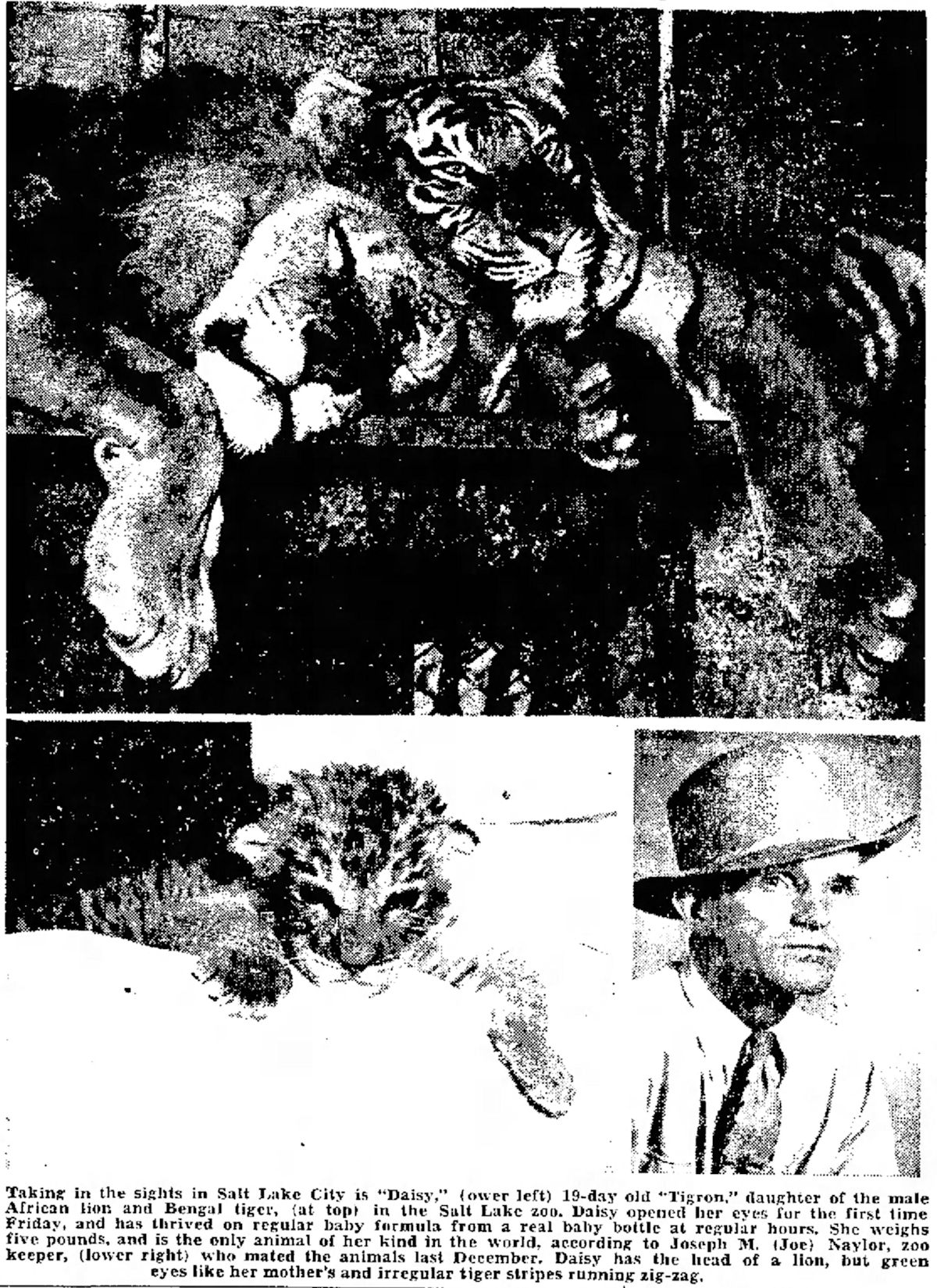
TIGER-LION HYBRID BORN. The Messenger (Madisonville, Kentucky), 7th May 1948.
A rare tiglon offspring of a lion and tiger was born at the Hogle Garden zoo yesterday. Joseph L. Sloan, superintendent of Salt Lake City parks, said as far as he can learn the hybrid is the first to be born in the United States. A similar one, born in Germany, is in the New York Central Park zoo, he said, and another is in London, England. Sloan said the tiglon has a large head like a lion cub, and its body is striped like a tiger.
TIGER-LION HYBRID TAKES EARLY LIKING TO BOTTLE. The Ogden Standard-Examiner (Ogden, Utah), 8th May 1948, pg 1.
Salt Lake City, May 8. This city s famous little tiglon cub is a bottle baby now. Parks Superintendent Joseph L. Sloan removed the rare hybrid animal from the cage of Daisie, tigress which gave birth to the cub Thursday, when he noticed Daisie wasn t paying much attention to her offspring. The new arrival has Huey, a lion, for its father. Yet to be named, the cub weighs about two pounds, is nearly eight inches long and four inches high. Sloan s wife is caring for the tiny cat in a flannel-lined box, equipped with a heating pad. At present she is feeding it one ounce of its formula every time it awakens. When it can take more substantial nourishment and its eyes are open, it will be placed on display in the zoo. The little cross-breed has a head larger than ordinary tigers, Sloan reported, and has prominent double stripes instead of the single stirpes worn by its mother. Sloan thinks the tiglon birth is the first in this country although one born abroad is now in a New York zoo.
In May 1948, there were several reports from Salt Lake City, proclaiming success. Throwing out all textbooks, the Salt Lake City Zoo has accomplished the supposedly impossible:- mating a full grown lion and tiger, traditionally deadly enemies. Mae and Huey are boxing playfully in 'their cage at the Hogle Zoological Gardens here these days, and the zoo Keeper, Joe Naylor, said Mae, the three-year-old tigress, was "expecting her first offspring either in mid-April or early May." I Lions and tigers have been mated before, but as far as zoologists know, not when brought together after reaching maturity. The German animal expert, Carl Hagenbeck experimented successfully in the field but his method was to rear the lion and tiger together from cub-hood. Some of the resulting progeny were sent to zoos In England and this country, but no case is on record of a successful mating In the United States. The hybrid offspring are variously called tiglions, Llgers" and ' similarly coined terms.
Naylor took nearly ten months to get his pair together. Mae had a twin sister, named Daisy, both born in the San Francisco Zoo. When the Hogle Zoo acquired Huey from Miami, Fla, he was placed in a cage four stalls from the young tigresses. Gradually Naylor moved the young lion closer to; the pair, cage by cage. Finally, they were in adjoining cages, and began a friendly, if somewhat cautious roaring acquaintance. Last summer Naylor told his boss, Joseph Sloan of the city parks department, his plans for mating the pair. I was told I was crazy,* Naylor said with a chuckle. And not only by local authorities. We had a visit last summer from experts of the Bronx Zoo in New York, and from several West Coast cities, including Seattle, San Francisco, Los Angeles and San Diego. They all told me I was nuts in even thinking about It; that I'd find a dead lion on my hands some morning.
In mid-December Naylor kicked open Huey s cage. I literally shoved him In with Daisy and Mae," he said. "At first they snarled at each other and the two tigers backed Huey into a corner. There was a little blood and some fur flew, but that lion was just plain scared to death." After a few days of armed truce. Naylor removed Daisy and left Huey and Mae together. 'Two days later they were as friendly as a couple of puppies; Naylor said. "They d box together in the mornings and romp all over the cage together. He said that on Dec 28 the pair were mated, and that the mating season lasted until Jan, 24. Naylor added that Mae shows all the signs of being expectant, and that It she is, the kittens are due In late April or early May. Tigers have a gestation period of 105 days and usually produce three cubs. Watching the two animals lying fondly together with the tigress' head nestled against the lion s shoulders, "Cupid Naylor rubbed his hands cheerfully. "They're mated now tor life he gloated, It d be a shame to break up such a happy home. And they said it couldn't be done. "
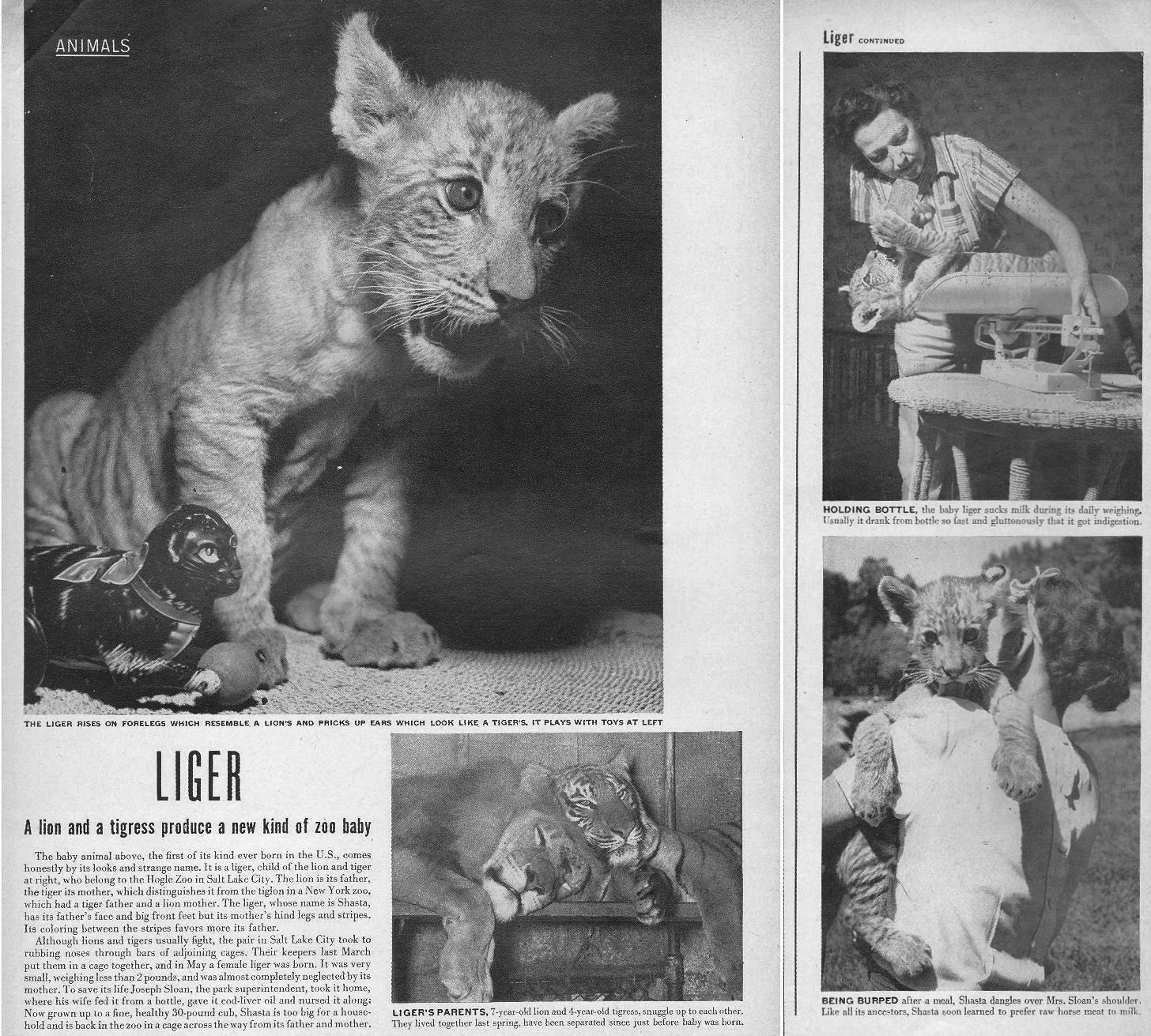
Another report in the same month gave a different account of the mating. A special circus-wagon cage and all the comforts expected by lions and tigers in captivity, will be provided for Salt Lake City s famous Tiglon" - or 'liger - when it is large enough to meet the public. The 19-day-Dld oddity now weighs slightly more than five pounds. Offers from zoos and circuses to buy the baby "Tiglon have been turned down, reports City Park Superintendent Joseph L. Sloan. The animal is bringing Utah a great deal of national publicity, it is pointed out, as there is no record of such another youngster in the world. "It is a Tiglon because its father is the lion and its mother the tiger, said Mr. Naylor. If its mother was a lion and its father a tiger it would then be called a Liger. [he gets this the wrong way round] The kitten, called Daisy, is being fed regularly from a real baby bottle and a regular baby formula is used. The kitten only weighed a pound and a half when it was born. It opened its eyes Friday, and they are more or less green, like her mother s, the tiger," points out Mr. Naylor. The father s eyes are a light yellow.
"The mating of lions and tigers in American zoos is possible in more than 50 per cent of the cases, if handled properly, declares Mr. Naylor, who was invited to Ogden to tell about the much-discussed 'Tiglon'. There is always the danger of the lion killing the tiger during the mating, however, unless one understands animals. I understand that a male tiger and a female lion who grew up together from cubs were mated in Germany, But, it is believed that this is the first time , in history that a male lion and a tiger were mated. The reason this was possible is because of a secret 'love medicine , obtained from an old-time friend of mine, Bill Gronenthial, who lives in Canada. [. . .] The lion and the tiger were so tame, and looked so lonesome, I began thinking about mating them. The more I thought about it the more I thought it could be done - even if everyone I talked to said that it never had been done and wasn t possible [. . .] I dropped Gronentbial a letter and told him what I proposed to do. I had some medicine which I had been experimenting with - a love potion which quieted down the animals. In addition to the vitamins given in their meal each Monday morning, I used the love potion every day for six months. Finally, when I figured they were ready for mating I raised the gate of 1hc lion's cage and let the king of the beasts enter the tiger s cage. That was November 28, 1947. There was perspiration on my brow. But instead of a snarling, raging fight, as some experts said would happen, it was a case of love at first sight. The two beasts set up housekeeping and were together until the first of April, when I put the lion back in his own cage. The vitamins and love potion made them friendly - and the Tiglon was the result of the mating.
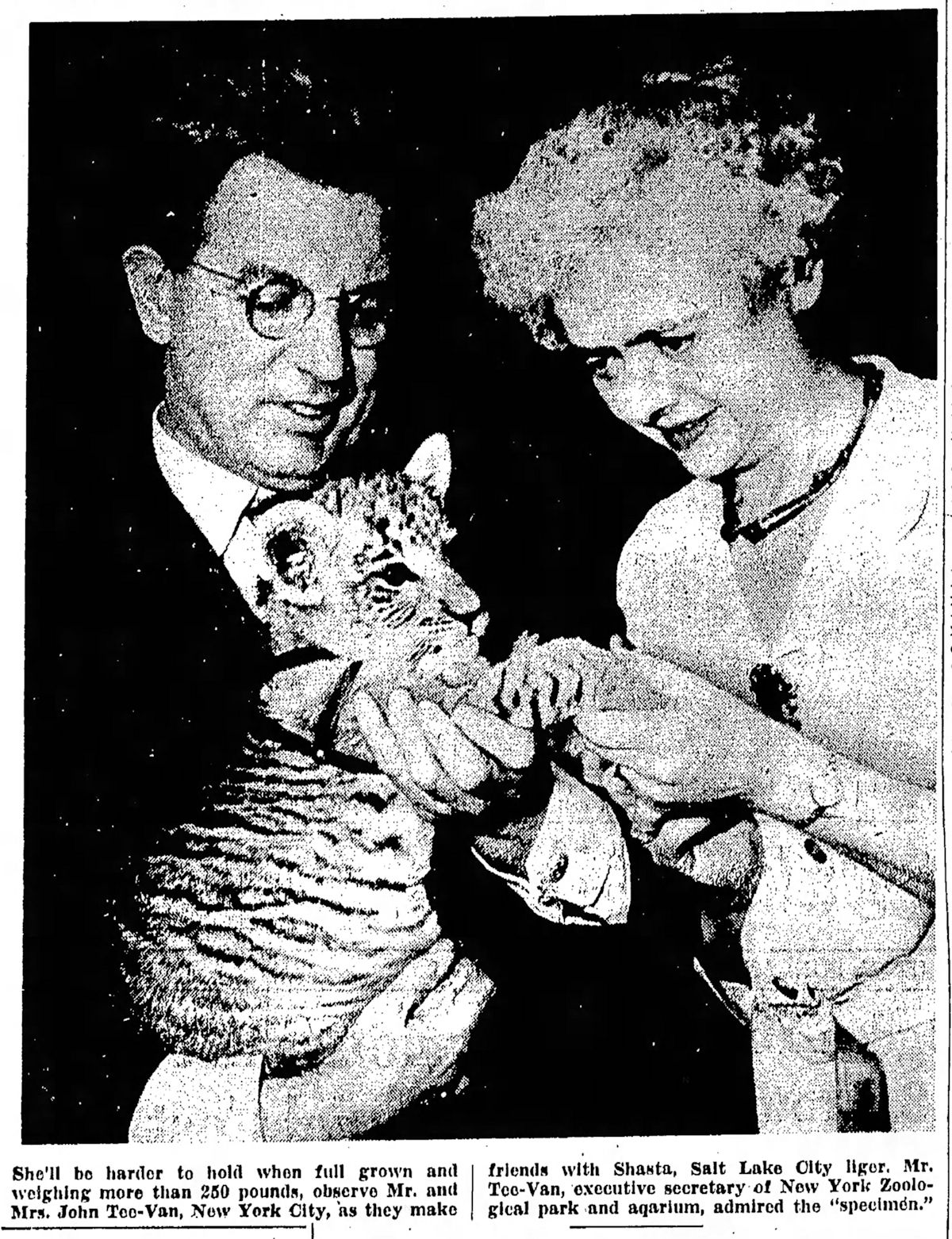
Shasta was born at the Hogle Zoo in Salt Lake City on May 14th, 1948. Shasta, Salt Lake City's world-famous liger" cub, makes her debut Saturday. Before the day is over the 17-pound daughter of a tiger mother and lion father will have seen a lot of people, and a lot of people will have seen her. But Parks Supt. Joseph L. Sloan isn t worried about the people. It's how Shasta reacts that worries me. ' he said Friday, in anticipation of the event. The 6-month-old cub will be removed from her present home at the Sloan residence hi Liberty park and placed in a wire enclosure on the center lawn of the Hogle Zoological gardens for public inspection. Since the cub's birth May 6, Mr. Sloan has had Inquiries from envious zoological experts in England, Australia, Mexico and Japan requesting more details on the hybrid. The cub has the head of a lion, and the ears, long body and tail of a tiger.<.P>
An article from September 10, 1948 mentions a one year old male Liger in the Salt lake City Zoo, which "may grow a mane". This was probably Shasta at the Hogle Zoo in Salt Lake City, although he was not 1 year old at the time.
Proving that hybrids need not be unhealthy or short-lived, Shasta the ligress, who lived at the Hogle zoo in Salt Lake City, set a longevity record. She was born at the Hogle Zoo in Salt Lake City on May 14th, 1948 and died in 1972 at age 24 (and an Indian tigon reached 25 years old). The 1973 Guinness world records reported the 18 year old, 750 lbs male liger living at Bloemfontein zoological gardens, South Africa in 1953.
|
1904 photo of circus lion tamer with 2 lions and a liger (Hagenbeck's travelling show) |
1904 photo of circus tigress, lion and hybrid offspring (Hagenbeck).
1904 photo of Hagenbeck's ligers |
|
May 8th, 1948: Hybrids of the Big Cats. A Salt Lake City news dispatch (reports : Attendants at the Hogle Garden zoo were stumped about whether the zoo s newest arrival was a tigron or a lioniger. The animal, said to be a cross between a tiger and a lion, was born yesterday to Daisy, a three year old tiger. The cub weighed about a pound and was approximately six and a half inches long. It has the striped body of a tiger and a head which is neither a lion s or a tiger s but resembles both. As the hybrid was born to a tigress, not a tiger and fathered by a lion its proper name is tigron. While the killing of hybrids in wild state have been reported they have not been verified, though many have been born in captivity. General R. G. Burton, who spent 40 years stationed in India and hunted the tiger every year, and is an acknowledged authority, says in his Book of the Tiger : "The ancestral type of the great cats may have been striped or spotted. Many of the tigers markings are like elongated rosettes, and both lions and tigers frequently exhibit spots. Evidence is also to be found in hybrids between the lions and spotted cats, for the lion has been crossed with both the leopard and the jaguar: in these cases the leonine characters appear to be dominated by those of the spotted animals. The male lion-tiger hybrid known as the tigron, named Ranji, after Ranjitsinkji, the Jam of Nawanagar, in which state it was bred, which lived in the regents' zoo for eight years, looked more tigrene than leonine, while although of a tawney color of the lion it had faint stripes. A hybrid between a tiger and a lioness, bred in Edinburgh also appears most tigrene. Other such hybrids have bred in manageries. In hybrids the more primitive type is biologically predominant. There is no authentical instance, the author continues, of a tiger-leopard hybrid but several abnormally marked leopards that may have been hybrids have been killed in leopard frequented districts of India.
TIGER-LION HYBRID IS UNUSUAL ANIMAL. The News and Observer (Raleigh, North Carolina), 22nd August 1948, pg 6-IV.
Salt Lake City s sensitive liger cub, a rare cross between a tiger and a lion, is being broken into the zoo routine of being looked at very gradually. The husky 16-pound cub, believed to be the only one ever born of a tiger mother, can be seen at the Hogle Gardens Zoo only two hours a week . . . Zoo officials say the other one or two tiger-lion hybrids known to be still living have been born of lion mothers.
FOUR LIGERS BORN. The Bridgeport Post (Connecticut), 13th December 1957, page 58. [and others] BOMBAY, Dec. 13. Four ligers, the rare offspring of a lion father and a tigress mother were born last night at the Victoria Gardens Zoo. Officials said they might survive. The mother is Mary, a royal Bengal tigress, and the father is Shankar, star lion of the circus menagerie. The animals have been cage companions for two years. Three of the gray ligers were delivered in rapid succession. The fourth arrived some hours later. The zoo superintendent said ligers are a rarer phenomenon than tigons, the offsprings of tigers and lionesses. The zoo bred one tigon 12 years ago [1945] but it did not live long.
In "At Home In The Zoo" (1961), Gerald Iles wrote "For the record I must say that I have never seen a liger, a hybrid obtained by crossing a lion with a tigress. They seem to be even rarer than tigons." In contrast, Iles was more easily able to acquire tigons for Belle Vue Zoo, Manchester.
September 16th, 1975: The last of three liger cubs born to a tjgress and a Hon at Osaka's Tennoji Zoo died Monday, apparently because the 1.1-pound cub was born prematurely. The three cubs were born a week ago to tigress Tama and her consort, the lion Takeo. The two were given a cage to share almost since they were born 4.5 years ago in hopes of producing littler ligers. Tama s first pregnancy last July ended in miscarriage. The three liger cubs were born at about half the weight of a normal lion or tiger cub. One died last Wednesday and another Thursday, but zoo officials had given the third - whose face resembled a tiger and body a lion good chances for survival. Three world zoos had ligers before World War II and the Salt Lake City zoo produced a tiger in 1948 that survived for three years.
|
|
Ligers, showing the variable appearance due to different gene interactions. |
|
Baron Julius Von Uhl (Shrine Circus) trained a male liger named "Ligey", born in 1989, and who lived to be 27 and weighed 800 lbs. According to the Hartford Courant (Connecticut), 24th September 1992, an Indiana couple, Sharon and Pat Hocktor, bred Ligey, along with about 40 other ligers. Liger was part of von Uhl's act alongside 11 lions. "As a baby, he would purr like a tiger, and growl like a lion, said Linda von Uhl, the baron s wife. Now 3 years old, Ligey is silent, like a tiger. "He s very playful, like a tiger, and easygoing." Ligers are created by a handful of commercial breeders in the world and are sold for $500 to $1,000 apiece. It's estimated there are about 40 in the country, all performing in animal shows.
Not all liger births are planned - in September 1975, a tigress sharing a cage with a lion at a zoo in Osaka, Japan, gave birth to 3 cubs described as having tiger's heads and lion's bodies. Two died soon after birth and the third was reported as "very poorly", presumably dying soon after the news report. In the 1980s, ligers were bred at the tiger park in Thoiry near Paris owned by Vicomte Paul de la Panouse who allowed lions and tigers to roam freely together; so freely they interbred. One of the ligers, Julie, produced a cub, though its paternity wasn't known. It was reported that in 1984 2 "ligrons" (ligers) mated and produced offspring, thus disproving that hybrids were sterile (The Gazette, Montreal, Quebec, May 14, 1988. p I3 ); but the sire of the 2nd generation was probably Julie's own sire, a lion.
Josip Marcan had a liger breeding program. He raised a male lion cub with a female tiger cub and bred them. Bombey, Marcan's half-ton male liger, the "gentle giant" performed with Beatty-Cole show. The historical photographs below, are in circulation described as Cubanacan the Alipore Zoo's li-tigon with Josip Marcan. Marcan was never Cubanacan s handler and Cubanacan never went outside of Alipore zoo or performed any circus tricks. The images are one of Marcan's ligers, possibly Bombey.

HYBRID LIGER IS CAT NOT TO HE CROSSED . METAERIE, La. (UPI, October 23rd, 1986). Wild animal trainer Josip Markan is breeding a zoological controversy with his part lion-part tiger curiosities known as ligers. The big cats being bred by the Yugoslavian-born circus performer have light ochre stripes similar to tigers but the males also sprout manes, like lions, and grow larger than either parent. We are going to develop a completely new species, said Markan during a recent performance stop of the Beattie and Cole Brothers Circus. It will be far more large, more intelligent and superior than the others. He said his two young ligers, which already are larger than their lion father, may become the largest living members of the feline family. Halfway through the season, I think we have a problem, now they are growing non-stop, he said. We have a monster here instead of a regular pet. Markan, who for 20 years, has tried to crossbreed tigers and lions, now says he has the only ligers in the world. He says he will continue producing ligers, which are not known to exist naturally, and sell them to zoos. Markan said he overcame the natural antipathy lions and tigers have toward each other by rearing a male lion cub and a female tiger cub together from birth. When the animals became sexually mature, he bred them. He said the female tiger was not artificially inseminated. Some zoologists question the ethics of such breeding, while others see oddities like the liger as a way to increase traffic at increasingly market-conscious zoos. They are fiddling around with, two different animals, said David Anderson, curator of the Audubon Zoo in New Orleans. This is distracting people from a responsible opinion of animals. The trend among American zoos is to oppose such genetic manipulation. Many feel the work of zoos is to protect and preserve endangered species rather than house such hybrids as white tigers and ligers. Economic considerations could force some zoos to change their outlooks, said Dr. Oliver Ryder of the San Diego Zoo.
LIGERTOWN. Ligertown (Ligertown Game Farm Inc) at Lava Hot Springs, a tourist town in rural south-eastern Idaho, was owned by Robert Fieber and Dotti Martin. It was a ramshackle and run-down compound and in September 1995, hunters had to kill 18 escaped African lions (a 19th was shot near to the compound a week later). The animals had become aggressive, mauled the owners and escaped the filthy conditions. Humane Society officials arrived to help care for the remaining 27 lions, tigers and ligers, and around 70 wolf hybrids, which were living in squalor. Twenty-four big cats and three ligers, some sick or deformed, went to the Wildlife Waystation. One of the ligers, Namibia, was discovered hiding under a pile of old carpet in a seemingly empty room, she was scared of humans. Despite her background, she lived into her 20s.
Previously, in 1984, authorities in Oregon had raided a Fieber s game ranch and charged him with 54 counts of animal neglect. Fieber moved to north-central Idaho, where a 250-pound lion he owned with Martin was shot after it escaped and stalked a horse. Fieber and Martin were ordered to build adequate cages for their animals to prevent more escapes, but instead moved to Lava Hot Springs in 1986 with their 14 lions and tigers. They were found guilty in 1989 of operating a private wildlife park without a permit, but the conviction was overturned because state laws defining a wildlife park were too vague. There was initially a small movement to make Ligertown a tourist attraction, but it was not opened to the public and it seemed that animals bred by Fieber and Martin were just being hoarded in the compound. Fieber and Martin were convicted of animal cruelty and other offences. The Ligertown complex built of scrap lumber, pallets, chicken wire and other scrap material - was razed, much to the relief of local residents. The 1995 Ligertown incident forced Idaho to enact new laws regarding exotic animals and animal cruelty.
In Amman Zoo, Jordan, Jassass, a 250 kilogram seven-year-old lion, and Warda, a 120 kg six year old tigress were introduced to each other on August 30, 2001. On this occasion, the tigress rebuffed the lion's overtures, but zoo keepers remained hopeful that the pair would eventually mate (to date there has been no success).
A liger born in 2002 at Fuzhou, Fujian Province, lived for more than 100 days. In July 2004, a liger cub born in a wildlife park in Hainan, China died of respiratory failure 72 hours after birth. It had been born to the tigress Huan Huan and a lion called Xiao Erhei. It was born underweight and its death was attributed to congenital respiratory failure. According to Hainan biologist Dr.Li Yuchun, only one out of 500,000 lion-tiger or tiger-lion cubs survive, due to differences in their chromosomes. Huanhuan had rejected the cub and it had been suckled by a domestic dog that had just whelped in the hope of getting colostrum. The zoo planned to breed further ligers and later produced Ping Ping, Ann and Dai Wei. In July 2006, they produced 4 more liger cubs. The parents and their 7 cubs lived together in a single enclosure.
On 6th December 2004, a Bengal tigress produced healthy liger cubs sired by an African lion. The Russian Information Agency Novosti claimed it to be the first ever liger produced from this combination (possibly the first in Russia). The parents lived in neighbouring caves in the Novosibirsk zoo and got used to each other. The female liger cub was named Zita and resembles her tigress mother with clear tiger stripes, but has a lion's background colour and many leonine features. Her brother remains with his parents in another Siberian zoo. In November 2005, three liger cubs were born in the Novosibirsk Zoo to an African lion and a Bengalese tigress. This second litter from the same pair is the result of a genuine attachment between the two big cats which have been housed in neighbouring cages since childhood. Staff at Novosibirsk Zoo are considering the possibility of scientific research into liger fertility. During 2005, two tigons and three ligers were bred at the Shenzhen safari park, in southern China (near Hong Kong).
The Valley Of The Kings sanctuary in Wisconsin has a liger named Nook. Liger cubs were born at the Ark zoo in Germany. A pair of ligers in Peking zoo, bred from an African lion and an Ussuri tigress. In April 2005, a liger (erroneously called a tigron) called Samil was born at the Italian Circus in Vigo, northwestern Spain. Samil is a cross between a female tiger and a lion and therefore is a liger.
In October 2008, three liger cubs were born at the winter zoo of circus Embell-Riva (Bellucci family) in Italy.
TODAYShow.com, 31st October 2008: An animal handler with thousands of hours of experience has died after being mauled by a 1,000-pound lion-tiger hybrid he was feeding at an Oklahoma animal sanctuary. Peter Getz, 32, had entered the big cat s enclosure on Wednesday while it was feeding, a violation of standard procedures. The hybrid cat, called a liger, bit Getz on the neck and back before other handlers rescued him and called 911. He was taken to a Tulsa hospital, where he died Thursday night . . . Getz had been a volunteer for more than a year at Safari s Wildlife Sanctuary in Broken Arrow, Okla., and reportedly had thousands of hours of experience dealing with animals at the Tulsa Zoo. . . The liger, a cross between a male lion and female tiger, is named Rocky. Ensign said the animal was donated to the sanctuary, which houses 200 animals, most of them either rescued or donated. She told KJRH that when Rocky was growing up, she used to ride him like a horse and that he has a gentle nature.
But [Animal Planet s Jeff] Corwin told Lauer that it doesn t matter how gentle a predator may be. This creature could have, by its nature, a very individualistic, nice personality, the animal expert said. But the truth is, a tiger that weighs hundreds of pounds only needs to have one bad moment, and one bad moment can be critical, if not lethal, to a human being.
It remains unknown why Getz entered the enclosure. An investigation by local authorities will attempt to determine that, and will decide whether Rocky should be allowed to live or be put down.
In many situations, the animal is destroyed because it has connected in a negative way and a dangerous way to human beings, and the truth is there s an increased opportunity for this animal to become even more dangerous, Corwin told Lauer. There are other questions behind the story, Corwin went on. What it really echoes to is a bigger situation, which is keeping these exotics in captivity for nonlegitimate purposes in the first place, he said. This is a rescue center, but what is the individual history of that liger? How did it get there?
The animal may have originated in neighboring Texas, which has no laws regarding the keeping and breeding of big cats. The exact number of big cats in Texas is unknown, but estimates have put the population of tigers in that state at between 2,000 and 4,000, which may represent the largest tiger population in the world . . . The sanctuary is a non-profit wildlife refuge. All staff members are volunteers. It is licensed and regulated through the Oklahoma Wildlife Department and the U.S. Department of Agriculture and is subject to the same rules as public zoos.
On 15th August 2010, Taiwan's first liger cubs were born in the private "World Snake King Education Farm" in Kuijen, Tainan county. The parents were a Bengal tigress called Beauty and an African lion called Simba. One of the 3 cubs died at birth and the remaining two were being hand-reared because the tigress made no attempt to nurse them. Zoo keeper Huang Kuo-nan said Simba and Beauty have shared the same cage since they were both small and they started mating three years ago, but Beauty had not previously conceived. Housing big cats together from young is not uncommon in private zoos. Breeding and crossing of rare protected animals is illegal in Taiwan so Huang is under investigation for breaking the law even though he claims he didn't mate the pair intentionally. However, earlier in 2010 Huang was accused of illegally trading tigers. He says that when he tried to separate the animals the lion "got very angry". The Tainan county government seized the surviving cubs, relocating them to a home for wild animals in another southern county. Huang faces a fine of up to NT$50,000 for unauthorised breeding of wildlife. In a similar case, a lion and jaguar in Canada that pined when separated produced unintended hybrids in a Canadian rescue centre.
Male liger Radar lives at the TigerWorld wild animal sanctuary at Rockwell, USA. At 15 weeks old, Radar was transferred from Florida to the Rockwell Animal Sanctuary. Noah s Lost Ark, Berlin Center, Ohio, USA, had 3 ligers, all female: Kira, Keenya and Sophie. Germany's Noah's Ark Zoo had two ligers named as Silly and Wahia. These were the survivors of a litter of three.
G Peters included several hybrids (liger, tigon, leopon, leguar) in his "Comparative Investigation of Vocalisation in Several Felids" published in German in Spixiana-Supplement, 1978; (1): 1-206.

Ligers and White Ligers at Jungle Island, Miami, and Myrtle Beach Safari in South Carolina
These were both run by Kevin Bhagavan Doc Antle. (The Doc is a bogus title from a fictitious institute.)
Jungle Island Park in Miami (formerly Parrot Jungle) had two ligers born in November 2013 from a white tigress and a white lion. Yeti and Odin, were born to first-time parents Ivory, a male African white lion, and snow white Bengal tigress Saraswati. Ivory and Saraswati are Jungle Island's wildlife ambassadors in residence. (Sources: Today.com and CBS Miami, 16th December 2013).
In January 2014, Myrtle Beach Safari in South Carolina, claimed to have produced the first ever white ligers (Yongin Farm Zoo may have beaten them to this by a few years) with four male cubs born to white lion "Lord Ivory" and a snow-white tigress called Saraswati. The cubs were named Yeti, Odin, Sampson and Apollo. Yeti and Odin are the same cubs, born to the same parents mentioned in the Jungle Island Park news reports.
The white ligers have creamy golden bodies with darker golden faces and narrow black stripes on the legs, paler brown stripes on the body and black spots on the face. The markings will fade as the cubs mature. The cubs were born in December 2013 and are nephews of a liger called Hercules, who is officially the world s largest cat at 922 lbs and 131 inches long. Founder and director of the safari, Dr Bhagavan Antle, who bred the animals, says he is sure Yeti will reach this size. Dr Antle bred his first ligers in 1988 (Sudan and Sampson), a second litter in 2002 (Hercules, Zeus, Sinbad and Vulcan),a single liger in 2010 (Aries); all 7 were sired by a lion called Arthur.
Note: In October 2020, Antle was accused of multiple counts of cruelty to animals and trading in endangered species. He had no permit for captive breeding of lions. He had acquired lion cubs with fictitious birthdates from another roadside zoo. (The Winchester Star, 25th June, 2021). The names of his roadside zoos were not legally registered, nor were his charities - donations went into the same account as zoo profits. He promoted his giant liger, Hercules, but investigators photographed skinny, neglected and diseased lions and tigers at his facility. He also sent tigers to the hellish Samutprakarn Zoo in Thailand and supported operators of canned hunts in Africa. Doc Antle T.I.G.E.R.S (The Institute of Greatly Endangered and Rare Species) .
When Jungle Larry's three tigons were born in 1969 there was only one other tigon living in the United States and only 10 worldwide. The fourth US tigon would have been Tanya, born in 1961.
|
WHITE LIGERS, GOLDEN LIGERS |
White tigers have been crossed with lions to produce white ligers. Everland Zoo (Yongin Farm Zoo) in Seoul, Korea claimed to have produced white ligers. Big Cat Rescue's white tiger apparently co-habitates with a lion, as it was the intention of the original owner to breed white ligers. Golden tigers have been crossed with lions to produce golden ligers. In theory snow white tigers could be crossed with white lions to produce truly white ligers. White tigons or golden tigons are also possible, but because tigons do not attain the huge size of the liger there is far less interest in breeding them.
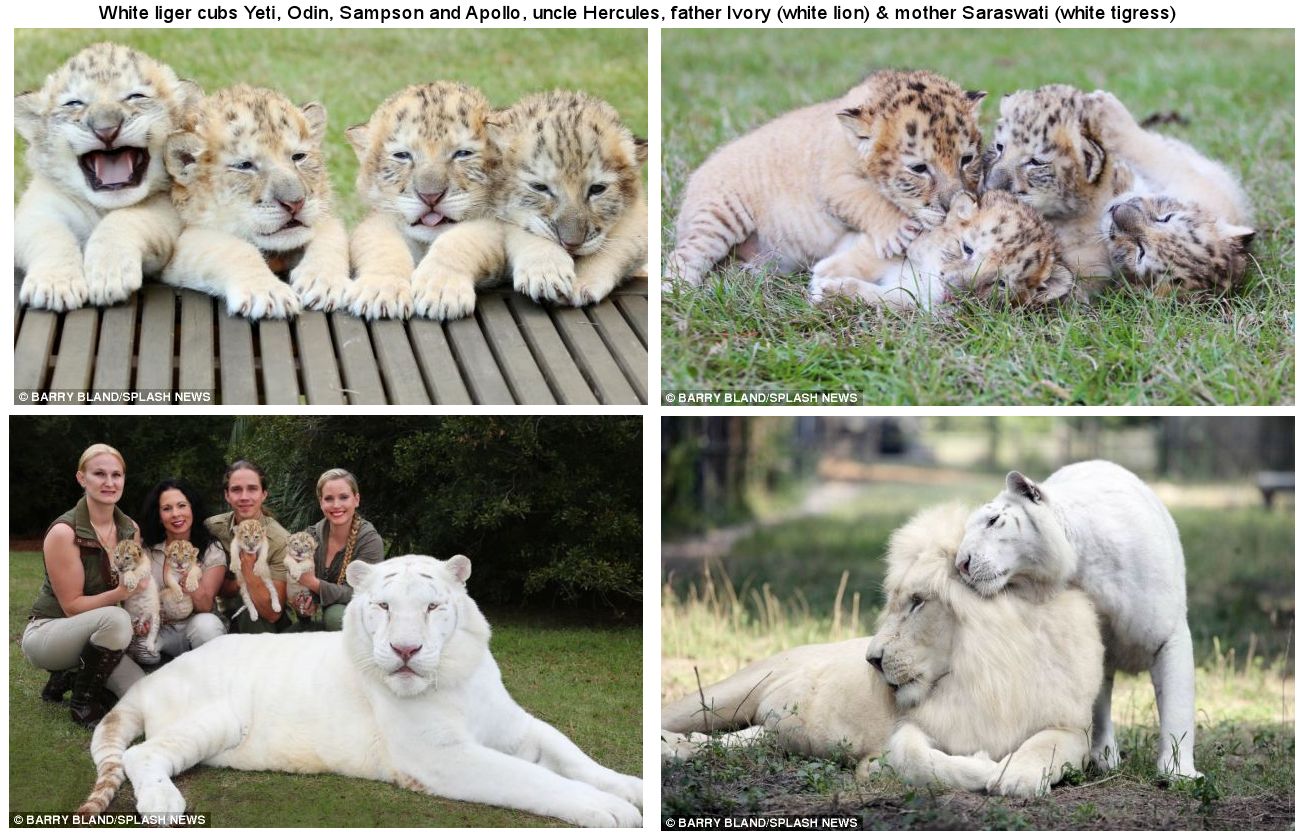
In January 2014, Myrtle Beach Safari in South Carolina, also claimed to have produced the first ever white ligers (although Yongin Farm Zoo may have beaten them to this by a few years). The four male cubs were born to white lion "Ivory" and a snow white tigress called Saraswati. The cubs were named Yeti, Odin, Sampson and Apollo. They have creamy golden bodies with darker golden faces and narrow black stripes on the legs, paler brown stripes on the body and black spots on the face. The markings will fade as the cubs mature. The cubs were born in December 2013 and are nephews of a liger called Hercules, who is officially the world s largest cat at 922 lbs and 131 inches long. Founder and director of the safari, Dr Bhagavan Antle, who bred the animals, says he is sure Yeti will reach this size. Dr Antle bred his first ligers in 1988.
A black liger would be an impressive creature, but to breed one would require both a melanistic tiger and a melanistic lion because the gene for black must be inherited from both parents and to guarantee a black liger requires both parents to be black. Very few true melanistic tigers have ever been recorded. Most "black tigers" are due to pseudo-melanism i.e. the markings are so heavy that the tawny background colour is almost hidden. No reports of black lions have ever been substantiated.
In felines, "blue" means a slate-grey colour. Genetically, it is a form of melanism where the colour has been diluted from black to grey. To breed a blue liger would require a blue (i.e.grey) tiger and a black lion (or black tiger and blue lion. Or blue tiger and blue lion). Blue tigers have been recorded in China, but none have occurred in captivity. To date, no grey lions have been recorded.
WHY ARE LIGERS SO MUCH BIGGER THAN TIGONS?
REFERENCES AND FURTHER READING
Historical accounts of ligers and tigons (chronological order): CJ Cornish et al (undated), R De Davison (1863), K Ackermann (1898), A R rig (1903), Deutshe Landwirtshaftliche Presse (1904), Boettger (1906), T Noack (1908), A Sokolowsky (1909), H Przibram (1910), SS Flower (1929), L Reisinger (1929), Sir PC Mitchell (1930), H Heck (1932), RI Pocock (1935), CWG Eifrig (1937), WA Craft (1938), L Heck (1941), VG Stefko and VP Narskii (1946), B E (1946), American Fur Breeder (1948), Illustrated (1948), H Pilcher (1948), B Grzimek (1949), A Urbain and J Rinjard (1950), P Leyhausen (1950), C Hagenbeck (1951), O Antonius (1951), H Petzsch (1951, 1956), M Burton (1952), A Kemner (1953), Farmer's Weekly Bloemfontein (1953), F Petter (1955), H Hemmer (1966, 1968), International Zoo Yearbook (1970, 1971)
Guggisberg, C. A. W. 1975. Wild cats of the world. Taplinger Publ. Co., New York
Leyhausen, P. 1950. Beobachtungen an L wen-Tiger-Bastarden mit einigen Bemerkungen zur Systematik der Grosskatzen. Z. Tierpsychol., 7:46-83.
Robinson's Genetics for Cat Breeders & Veterinarians 4th Ed (the current version)
LIGER, LIGER - WITH APOLOGIES TO WILLIAM BLAKE
Liger, liger, burning bright,
Such huge weight and such great height,
What immortal hand or eye
Could frame thy fearful symmetry?
Huge as pony, hearth-cat tame,
Unlike the cats for whom you're named
Tigress mother, lion sire,
But you inherit neither's ire.
Your threat to man not wrath, but size;
While there's no malice in your eyes,
The hazard lies in frame and strength -
In play you may endanger men.
Liger, liger, burning bright,
Half-hearted in both mane and stripe,
No place does nature have for thee,
Bred by men's curiosity.
Textual content (except for "Liger, Liger") is licensed under the GFDL.
|
BACK TO HYBRID & MUTANT BIG CATS INDEX |